Birds are remarkable creatures that have fascinated humans for centuries. One of the most mesmerizing aspects of birds is their ability to fly, which allows them to explore vast regions, migrate thousands of miles, and escape from predators swiftly.
Some birds are known to soar high in the sky, while others can hover or dart through the air with incredible speed and precision.
The unique features of birds’ wings and their mastery of aerodynamics make them some of the most graceful animals on the planet.
In this article, we will delve into the fascinating realm of birds in flight, exploring the mechanics of their wings and the techniques they use to stay aloft.
51 Flight Birds You Should Know
There are thousands of bird species in the world, but here is a list of 51 flight birds from various regions that you might find interesting and should know about:
1. Gulls
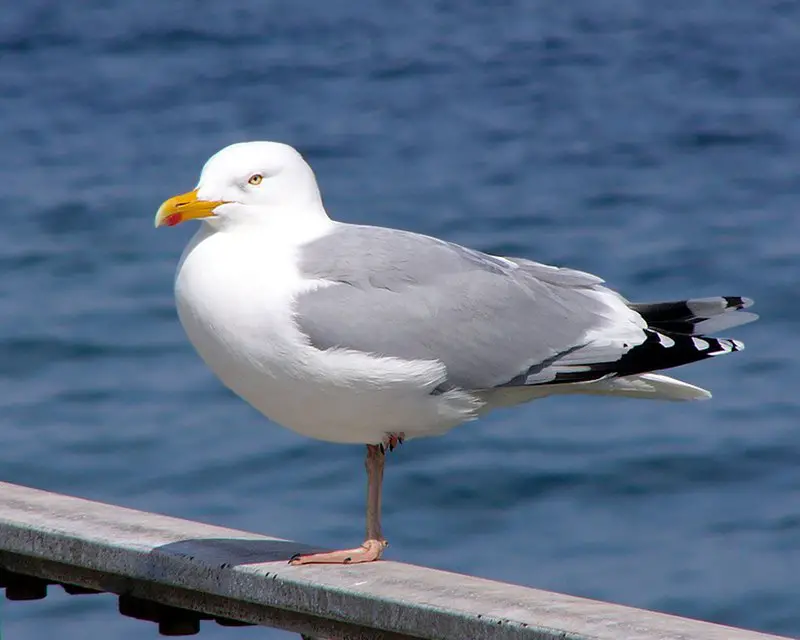
Gulls are a type of seabird in the family Laridae found worldwide. They are highly adaptable, often seen soaring above shorelines or near bodies of water.
Gulls have strong wings and long bills and vary greatly in size, colouration and behaviour from one species to another.
Some gull species feed on fish, while others scavenge for food such as insects, small mammals, or discarded human refuse.
Despite their different dietary habits, they all share common traits, including webbed feet, which enable them to swim gracefully through the water after prey items like crabs or molluscs.
Gulls generally nest close to the shoreline, where there is an abundance of available food sources, making them excellent hunters who can live comfortably both on land and at sea.
Scientific classification:
| Kingdom | Animalia |
| Phylum | Chordata |
| Class | Aves |
| Order | Charadriiformes |
| Suborder | Lari |
| Family | Laridae Rafinesque, 1815 |
Also Featured In: Most Common Birds in China, Ukrainian Birds You Should Know
2. Spoon-Billed Sandpiper
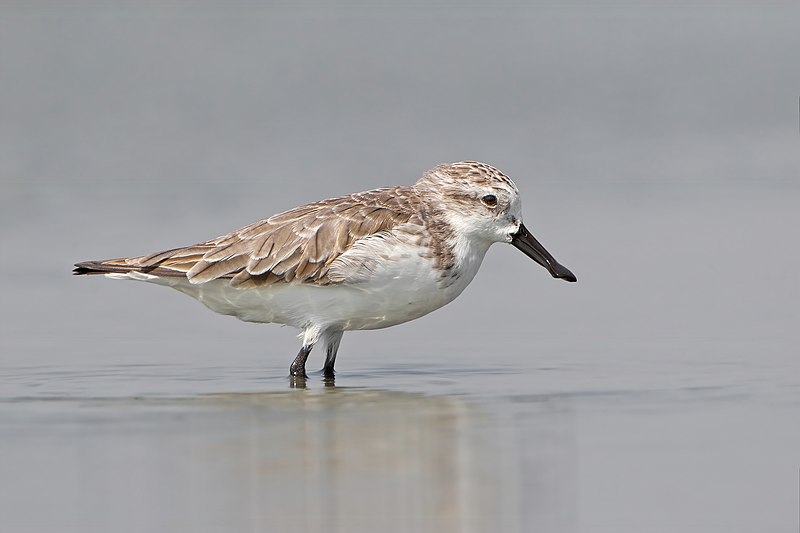
The spoon-billed sandpiper is a small wader that has been facing a drastic population decline since 1970.
It breeds in the Bering Sea, and winters in Southeast Asia, yet its estimated breeding population of 350 to 500 by 2000 reveals how greatly it has suffered from human activities such as overfishing and habitat destruction.
Its scientific name, Platalea pygmea, was proposed by Carl Linnaeus, highlighting how rare this species is.
This bird’s unique beak shape allows it to feed on crustaceans, worms, larvae and other invertebrates – however, without conservation efforts, these birds may soon vanish forever.
Scientific classification:
| Kingdom | Animalia |
| Phylum | Chordata |
| Class | Aves |
| Order | Charadriiformes |
| Family | Scolopacidae |
| Genus | Calidris |
| Species | C. pygmaea |
Also Featured In: Urban Birds of Hong Kong,
3. Bar-Headed Goose
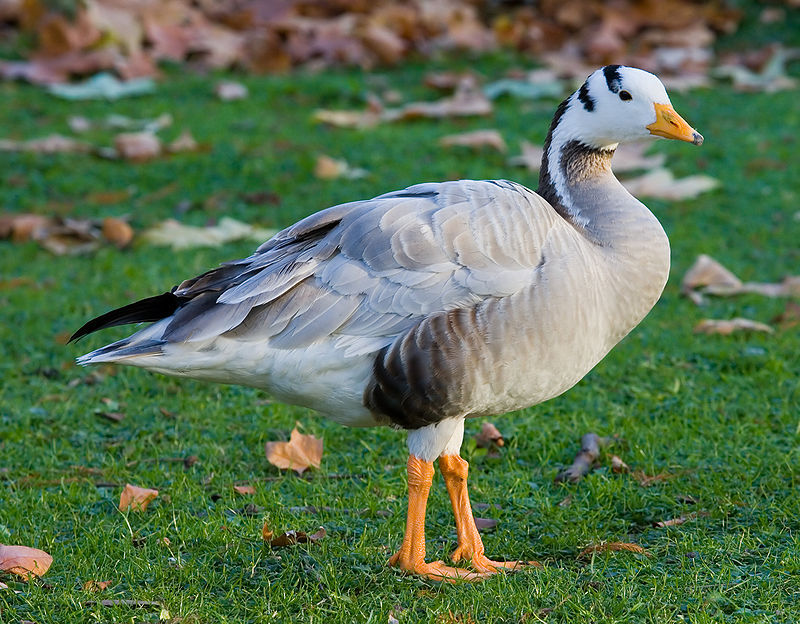
The Bar-headed Goose is an iconic bird of Central Asia, known for its remarkable ability to reach extreme altitudes when migrating over the Himalayas. It breeds in colonies near mountain lakes and winters as far south as India.
It lays three to eight eggs at a time in ground nests during breeding season. This grey goose genus Anser has no other native member species within the Indian region.
Its wings are adapted for high-altitude flight, being long and pointed with small “fingers” along their length that help reduce air turbulence during rapid ascent or descent through mountainous regions.
The bar-headed goose’s strong flying skills have made it one of nature’s most impressive avian migrations.
Scientific classification:
| Kingdom | Animalia |
| Phylum | Chordata |
| Class | Aves |
| Order | Anseriformes |
| Family | Anatidae |
| Genus | Anser |
| Species | A. indicus |
Also Featured In: Common Birds in India, Birds of Karnataka
4. Bald Eagle
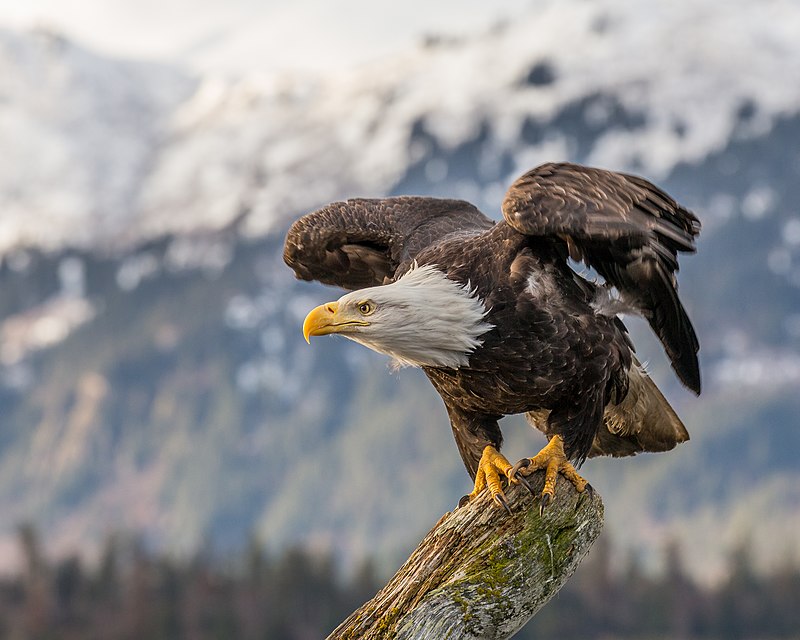
The majestic Bald Eagle is a bird of prey found in North America and recognized as the national symbol of the United States.
With its distinctive white head, brown body and striking yellow beak, this sea eagle has two known subspecies that form a species pair with the White-tailed Eagle.
It inhabits much of Canada, Alaska, all states in the US, contiguous areas, and Northern Mexico near large bodies of water where they feed mainly on fish.
These birds have an impressive wingspan ranging from 1.8 to 2 meters depending on their size, making them one of nature’s most magnificent creatures.
Scientific classification:
| Kingdom | Animalia |
| Phylum | Chordata |
| Class | Aves |
| Order | Accipitriformes |
| Family | Accipitridae |
| Genus | Haliaeetus |
| Species | H. leucocephalus |
Also Featured In: Most Common United States Birds, Birds That Live in Colorado
5. Peregrine Falcon
The Peregrine Falcon is a majestic bird of prey belonging to the family Falconidae. It has a blue-grey back, barred white underparts and a black head, making it easily recognizable.
This intelligent raptor, one of the fastest animals in existence, is known for its incredible speed, reaching over 320 km/h (200 mph) during hunting dives.
The peregrine falcon can be found worldwide, from Arctic tundra to tropical rainforests, thriving with humans or in high alpine mountains far away from civilization.
Their beauty, power and adaptability make them an impressive species that have earned respect among many cultures throughout history as symbols of strength and endurance.
Scientific classification:
| Kingdom | Animalia |
| Phylum | Chordata |
| Class | Aves |
| Order | Falconiformes |
| Family | Falconidae |
| Genus | Falco |
| Species | F. peregrinus |
Also Featured In: Birds of Sweden, Birds that Live in the Deserts
6. Anna’s Hummingbird
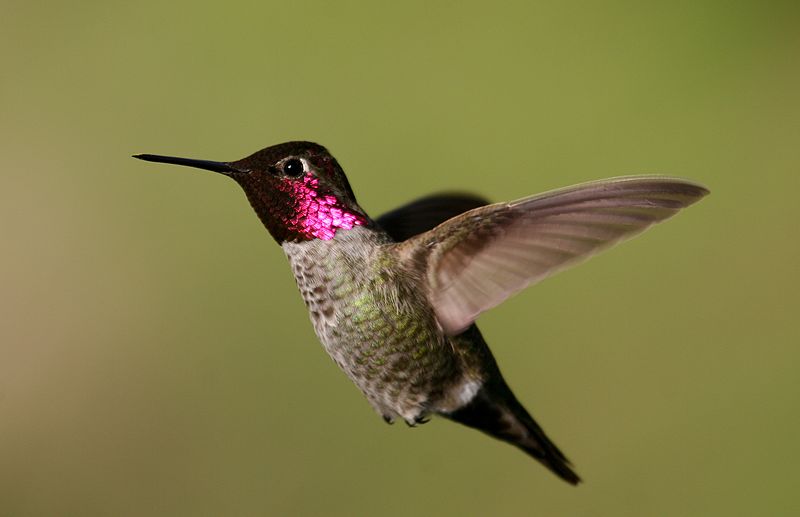
Anna’s hummingbird is a beautiful species of bird belonging to the Trochilidae family. Native to western coastal regions of North America, it was named after Anna Masséna, Duchess of Rivoli.
In the early 20th century, these birds bred only in northern Baja California and southern California, but due to ornamental plant transplanting, they can now be found across much of the Pacific Coast region.
They are medium-sized with bright emerald green feathers on their back and crowns as well as rose-red patches at the throat for males, making them quite distinguishable from other birds.
Their diet consists mainly of nectar from flowers, although they will occasionally feed on insects or spiders, making them important pollinators that help maintain healthy ecosystems.
Scientific classification:
| Kingdom | Animalia |
| Phylum | Chordata |
| Class | Aves |
| Order | Apodiformes |
| Family | Trochilidae |
| Genus | Calypte |
| Species | C. anna |
Also Featured In: Most Common Winter Birds, Birds Live Near San Diego
7. Hummingbirds
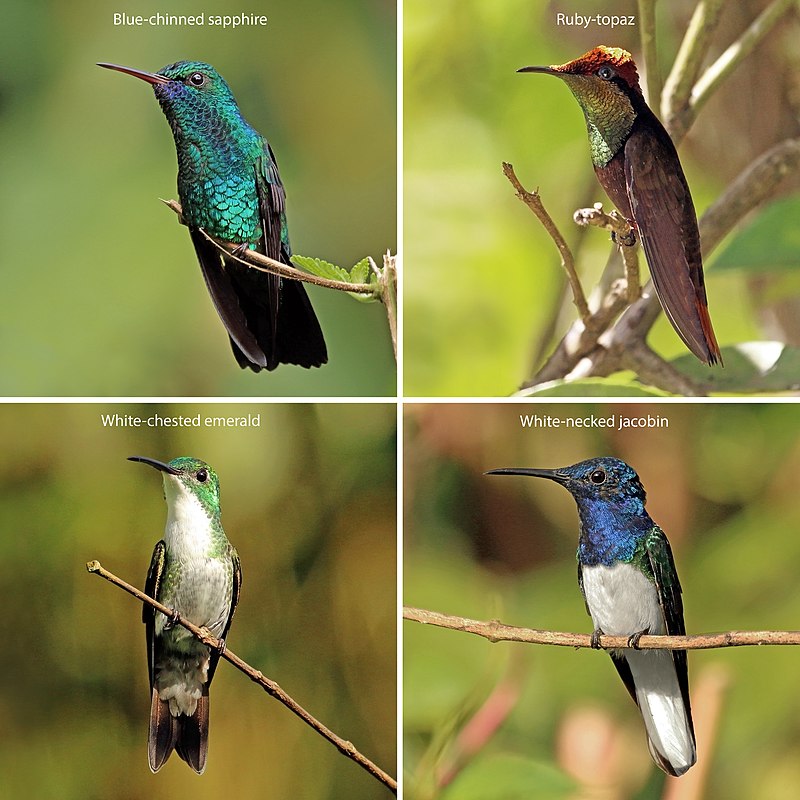
Hummingbirds are tiny birds found throughout the Americas, from Alaska to Tierra del Fuego. Most species measure between 3-5 inches in length and weigh less than an ounce.
The smallest hummingbird is only 2 inches long. Hummingbirds have a unique ability to hover by rapidly flapping their wings up to 80 times per second.
They feed on nectar and insects, with some species even able to drink sap or eat pollen directly off flowers.
Their vibrant colours make them instantly recognizable as they dart through gardens searching for food and mates.
Hummingbirds truly bring joy into our lives as they remind us that nature’s beauty can be seen around every corner if we take the time to look for it.
Scientific classification:
| Kingdom | Animalia |
| Phylum | Chordata |
| Class | Aves |
| Order | Apodiformes |
| Family | Trochilidae Vigors, 1825 |
Also Featured In: Rainforest Birds You Should Know, Most Common Nature Birds
8. Barn Swallow
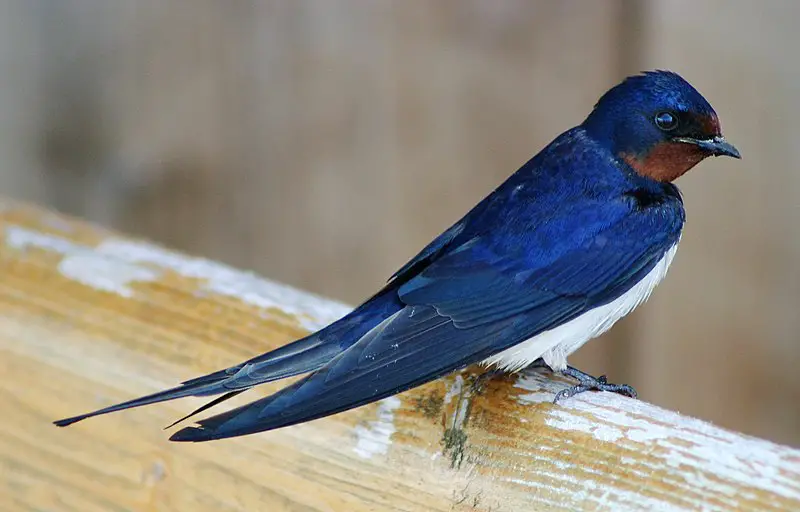
The Barn Swallow is a beautiful passerine bird with blue upperparts and a long, deeply forked tail. Found in Europe, Asia, Africa and the Americas.
It has an astonishingly large natural distribution spanning 251 million square kilometres globally, likely making it one of the world’s most widespread species.
This swallow typically nests near human habitation and other open areas such as fields or grasslands, providing them with suitable invertebrate prey to feed on.
They are insectivorous birds that often fly together in flocks looking for food over rivers or marshes, usually just above tree-top level.
The barn swallow can also be identified by its strong flight consisting of swift, continuous wing beats interspersed with glides during which they hold their wings slightly raised at the shoulders, giving them distinct V-shaped silhouettes in the sky.
Scientific classification:
| Kingdom | Animalia |
| Phylum | Chordata |
| Class | Aves |
| Order | Passeriformes |
| Family | Hirundinidae |
| Genus | Hirundo |
| Species | H. rustica |
Also Featured In: Most Popular Bird Species in North America, Birds that Live in Croatia
9. Dunlin
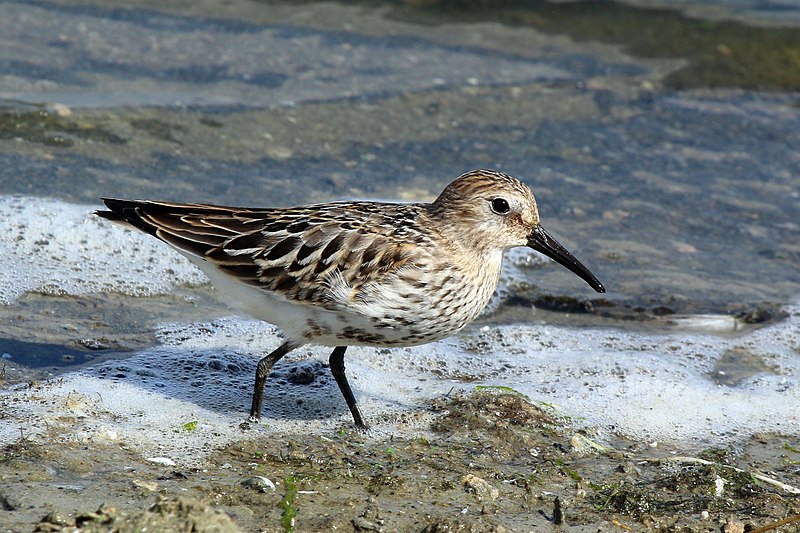
The Dunlin is a small wader, formerly known as part of the stint family. It has dull brown feathers, and its name is derived from the dialect word “dunling”.
This bird breeds in Arctic or subarctic regions during summer months but migrates to warmer climates during winter.
The Dunlin feeds on insects and invertebrates, which it finds in mudflats and shallow waters.
During the breeding season, they form large flocks containing thousands of birds. They are also well-known for their impressive synchronized flight patterns resembling waves moving through the sky.
Scientific classification:
| Kingdom | Animalia |
| Phylum | Chordata |
| Class | Aves |
| Order | Charadriiformes |
| Family | Scolopacidae |
| Genus | Calidris |
| Species | C. alpina |
Also Featured In: Estuaries Birds, Common Birds in Prince Edward Island
10. Bar-Tailed Godwit
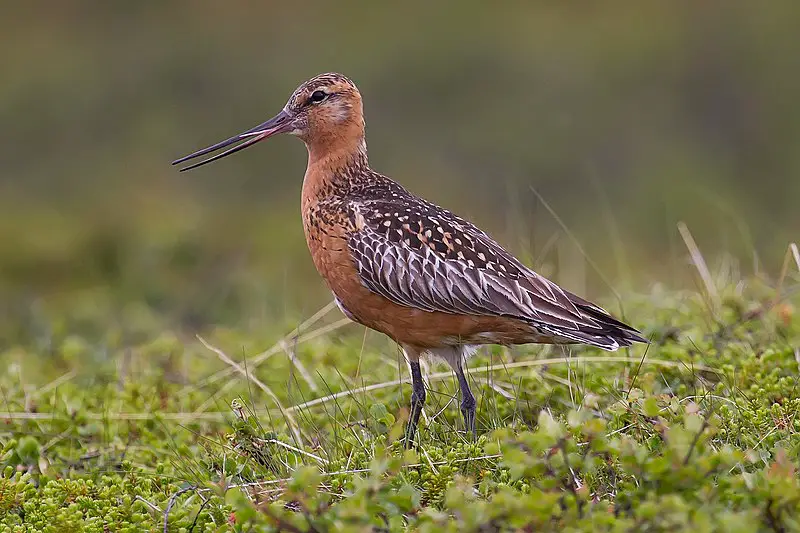
The bar-tailed godwit is a remarkable bird in appearance and behaviour. Its striking red breeding plumage stands out amongst the typical browns of other waders.
Long legs help it traverse coastal mudflats and estuaries where it forages on bristle worms and shellfish.
It has an upturned bill that gives it further distinction from other shorebirds.
Bar-tailed godwits breed on Arctic coasts stretching all the way to Alaska during summer months before migrating south towards warmer temperate or tropical regions for wintering each year – quite incredible.
Despite their long migratory journeys, they are still considered a common species due to large numbers making these arduous trips annually, although some populations have experienced declines recently.
Scientific classification:
| Kingdom | Animalia |
| Phylum | Chordata |
| Class | Aves |
| Order | Charadriiformes |
| Family | Scolopacidae |
| Genus | Limosa |
| Species | L. lapponica |
Also Featured In: Russian Birds, Tundra Birds
11. Spur-Winged Lapwing
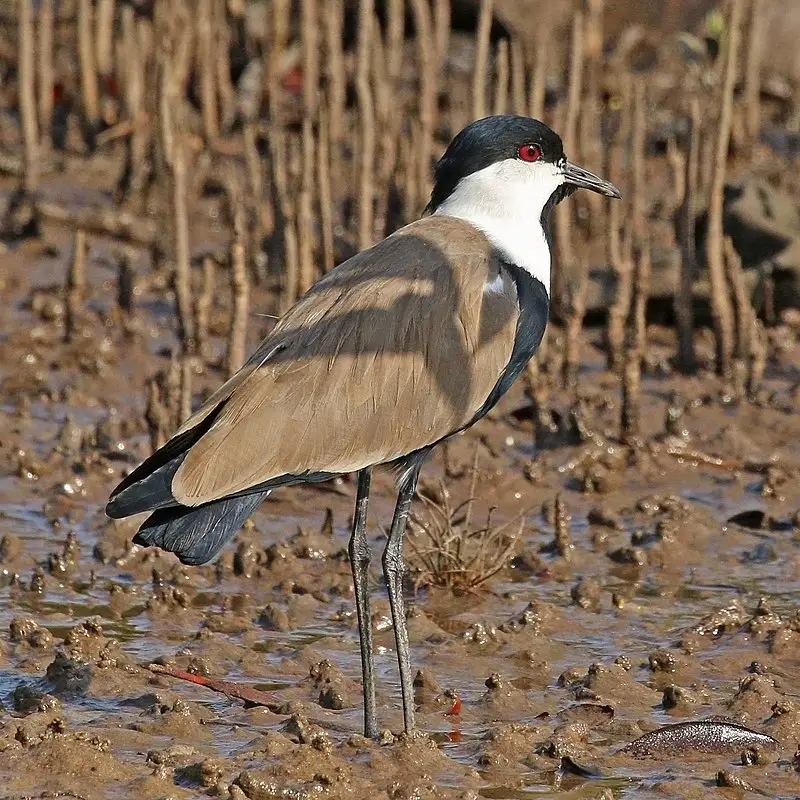
The Spur-winged Lapwing is a species of wader found in the family Charadriidae.
It breeds around the eastern Mediterranean and Africa, inhabiting savannahs, wetlands and grasslands.
Its plumage is mainly black with white wing stripes and yellow legs.
This bird has an impressive crest on its head that gives it a distinctive look amongst other lapwings.
The most interesting feature of this bird is the spurs on its wings, which are believed to be part of an unattested cleaning symbiosis between them and Nile crocodiles.
It feeds mostly on insects, larvae, worms, and some plant material such as seeds or fruits.
These birds can live up to 15 years in their natural habitat, making them one of the longest-lived among all wading species.
Scientific classification:
| Kingdom | Animalia |
| Phylum | Chordata |
| Class | Aves |
| Order | Charadriiformes |
| Family | Charadriidae |
| Genus | Vanellus |
| Species | V. spinosus |
Also Featured In: Common Ethiopian Birds, Common Birds of Lesbos Island
12. Ibis
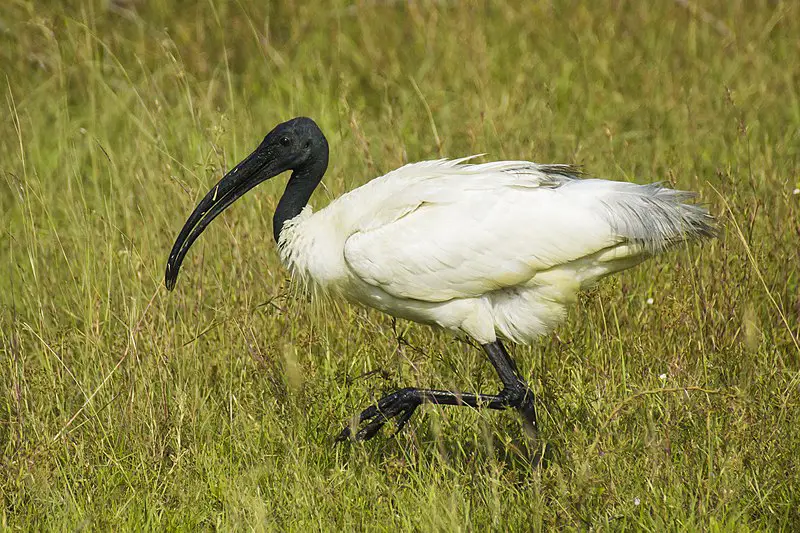
Ibis is a type of long-legged wading bird belonging to the family Threskiornithidae. They inhabit wetlands, forests and plains across many parts of the world.
The name ibis comes from Latin and Ancient Greek words for this group of birds, which can also be found in scientific names like Bubulcus ibis, which was mistakenly identified as a bovine animal in 1757.
Ibises have characteristically curved bills used to capture food items such as fish, reptiles or frogs with their feet while they are searching through mud or shallow water.
Furthermore, these birds usually live in large flocks, which helps them protect themselves against predators by watching for each other’s safety during hunting times.
Scientific classification:
| Kingdom | Animalia |
| Phylum | Chordata |
| Class | Aves |
| Order | Pelecaniformes |
| Family | Threskiornithidae |
| Subfamily | Threskiornithinae Poche, 1904 |
Also Featured In: Egyptian Birds, Swamps Birds You Should Know
13. Eurasian Crag Martin
The Eurasian crag martin is a small passerine bird in the swallow family, measuring 14 cm long.
It boasts ash-brown upperparts and paler underparts, with a short square tail featuring white patches on most of its feathers.
This species breeds in southern Europe, northwestern Africa, and the Palearctic region.
Though looking similar to other martins, such as Alpine or Rock Martins, it can be distinguished by the less extensive dark markings on its neck and throat that lack any brownish tinge.
Crag Martin’s diet consists mainly of insects which are caught while flying low over open areas near rocks or cliffs – hence their name.
Scientific classification:
| Kingdom | Animalia |
| Phylum | Chordata |
| Class | Aves |
| Order | Passeriformes |
| Family | Hirundinidae |
| Genus | Ptyonoprogne |
| Species | P. rupestris |
Also Featured In: Birds Commonly Found in Slovenia,
14. Eurasian Eagle-Owl
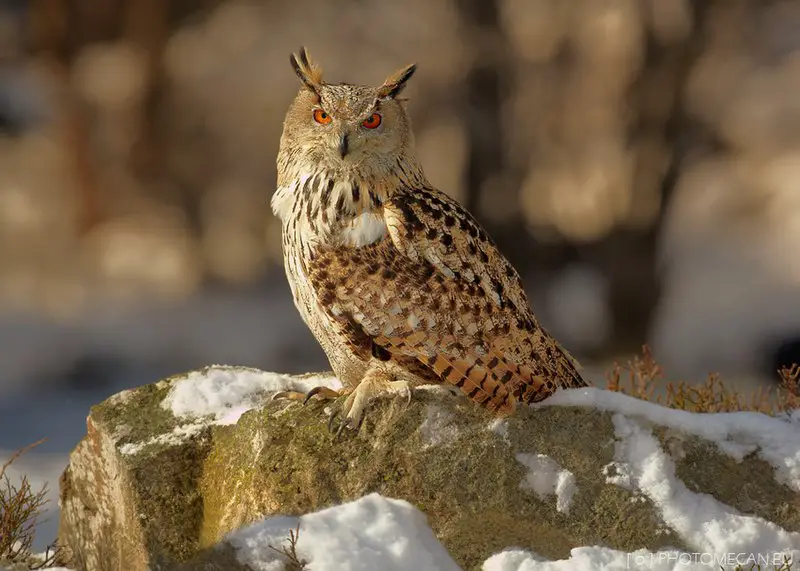
The Eurasian eagle-owl is a majestic bird that inhabits much of Eurasia. It has an impressive wingspan of up to 6 ft 2 in, and females can reach lengths of 30 inches.
The Uhu, as it is sometimes called, boasts distinctive ear tufts which are easily visible against its mottled brown plumage.
This powerful owl prey on small mammals like rodents and hares; however, due to their large size, they have been known to hunt larger prey such as foxes or even deer.
They usually nest in cavities high off the ground but use manmade structures if available.
With their prominent presence across Europe, these birds are often seen perched atop trees during the day before setting out for hunting at night – truly magnificent creatures.
Scientific classification:
| Kingdom | Animalia |
| Phylum | Chordata |
| Class | Aves |
| Order | Strigiformes |
| Family | Strigidae |
| Genus | Bubo |
| Species | B. bubo |
Also Featured In: Native Birds Of Germany, Birds You’ll Find in Moldova
15. Barn Owl
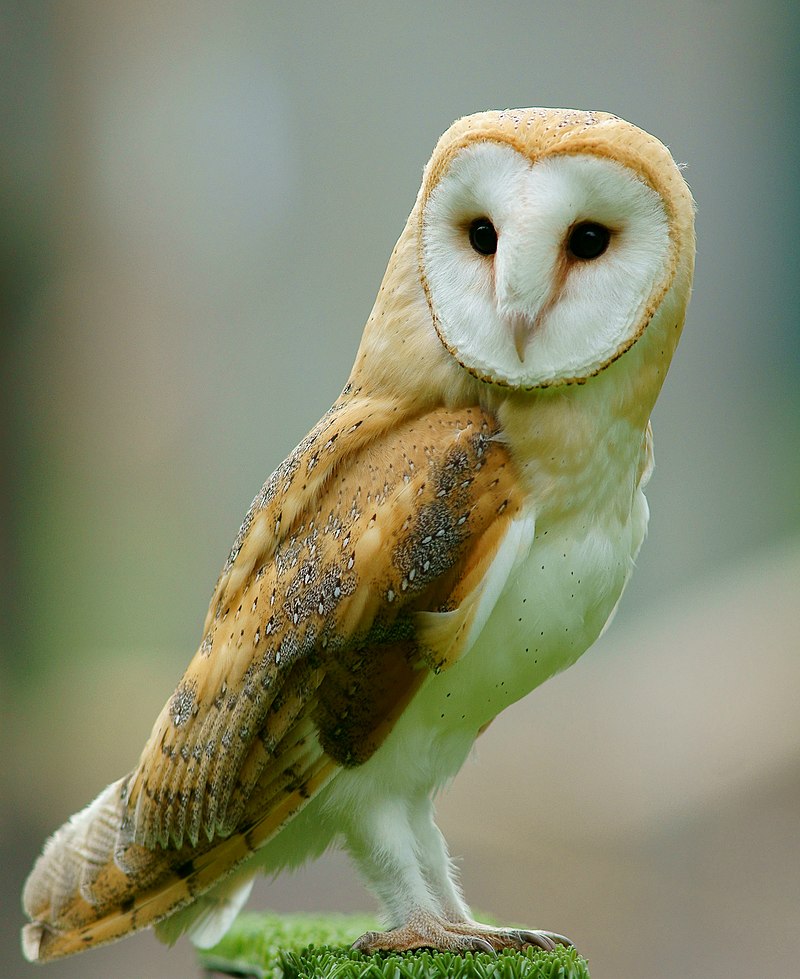
Barn owls are a beautiful and fascinating bird species worldwide, except in polar and desert regions, most of Indonesia, and some Pacific Islands.
They have large eyes, thin legs, and long wings that help them hunt silently in low-light conditions.
Their white colouring helps them blend into their surroundings, making catching prey easier.
Barn owls are nocturnal hunters using their impressive hearing capabilities to locate rodents moving within vegetation or underground tunnels.
They also feed on insects such as beetles, moths, etc., which they can detect from high up in flight using their excellent vision even at night.
The barn owl plays an important role in balancing ecosystems by controlling rodent populations, which is why they should be protected wherever possible so that this vital service continues uninterruptedly.
Scientific classification:
| Kingdom | Animalia |
| Phylum | Chordata |
| Class | Aves |
| Order | Strigiformes |
| Family | Tytonidae |
| Genus | Tyto |
| Species | T. alba |
Also Featured In: Belarus Birds You Should Know, European Birds
16. Black-Headed Gull
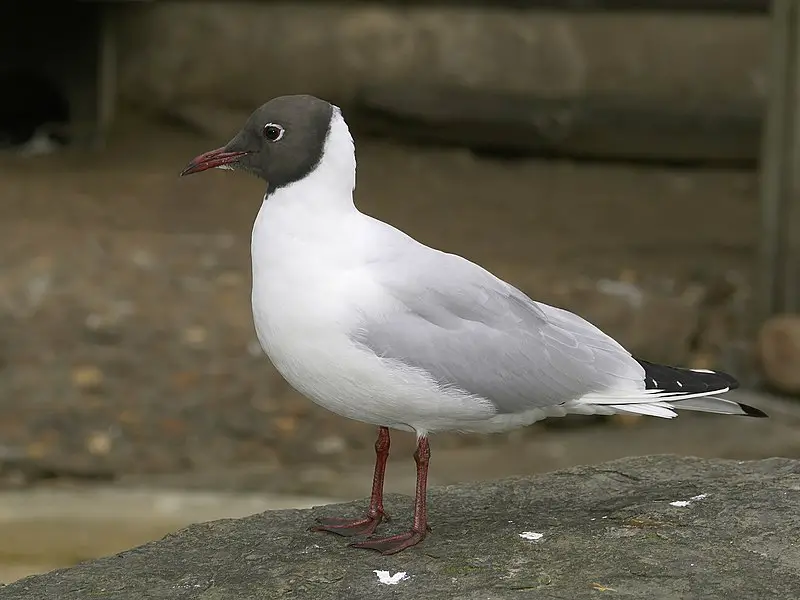
The Black-headed Gull is a small, migratory bird found in much of the Palearctic. It breeds mainly in Europe and coastal eastern Canada but can also be found further west in milder areas.
In North America, it’s known as the Common Black-headed Gull.
Its plumage consists of grey on top with white underneath, while its head has a distinctive black cap during breeding season, which fades to brown outside of this period.
They are often seen by coastlines or near inland waters where they feed off fish, insects and crustaceans caught either from the surface or underwater depending on their preference at that time.
Scientific classification:
| Kingdom | Animalia |
| Phylum | Chordata |
| Class | Aves |
| Order | Charadriiformes |
| Family | Laridae |
| Genus | Chroicocephalus |
| Species | C. ridibundus |
Also Featured In: Birds of United Kingdom, Birds of Orkney
17. Barnacle Goose
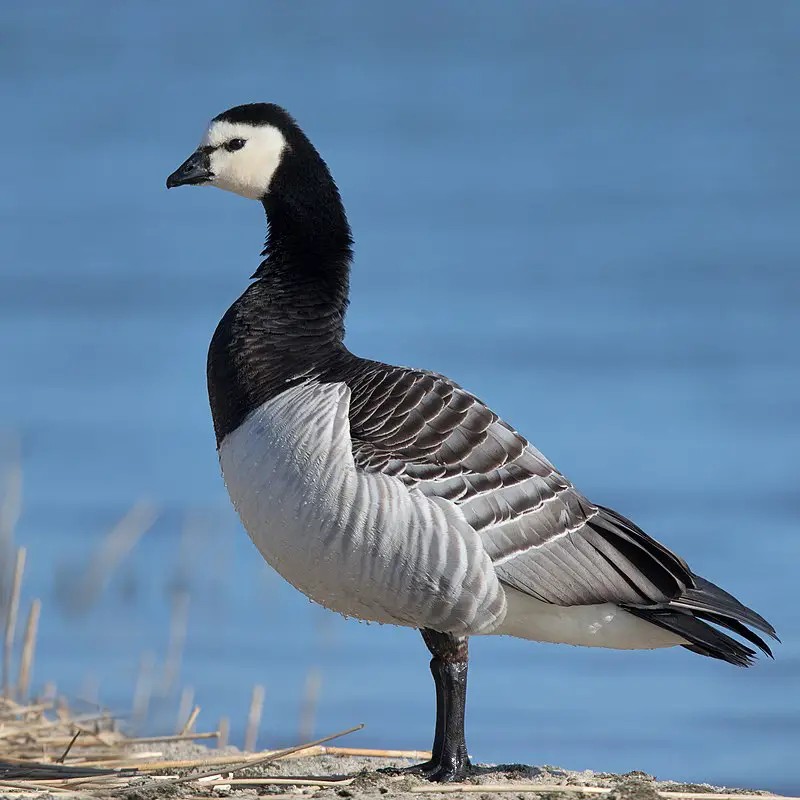
The Barnacle Goose is a species of black goose from the Branta genus. It has mostly black plumage and can be distinguished from other types of geese, such as grey Anser species, by its unique colouring.
This bird was first classified taxonomically in 1758, and genetic studies have recently revealed that it is actually related to the Cackling Goose lineage rather than brant geese, to which it bears resemblance.
The barnacle goose lives all around northern Europe during winter months but travels further north into Greenland or Svalbard for breeding season, when they will lay eggs on cliffs close to water sources so their young ones may take advantage of food-rich waters below them easily after hatching.
Scientific classification:
| Kingdom | Animalia |
| Phylum | Chordata |
| Class | Aves |
| Order | Anseriformes |
| Family | Anatidae |
| Genus | Branta |
| Species | B. leucopsis |
Also Featured In: Most Common Scotland Birds, Birds that Live in Svalbard
18. Swallows
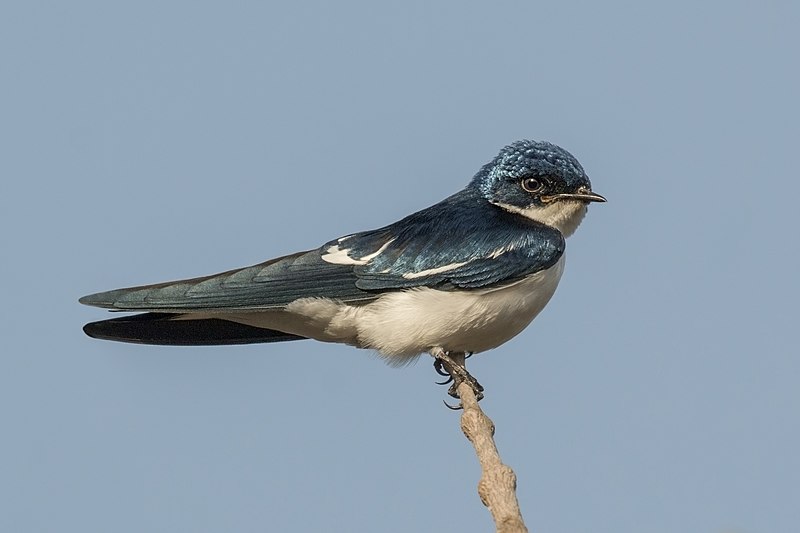
Swallows are small songbirds found worldwide on all continents, even Antarctica. They have a distinctive appearance and are highly adapted to aerial feeding with their long wings and forked tails.
There are an estimated 90 species of swallows in 19 different genera, making them one of the most widespread bird families on earth.
The barn swallow is perhaps the most well-known species among these birds due to its presence near human settlements across Europe; they’re so ubiquitous that “swallow” has become synonymous with this particular type of bird there.
Swallows also play important roles in ecology as insectivores; some species migrate vast distances yearly between summer breeding grounds and wintering locations.
Scientific classification:
| Kingdom | Animalia |
| Phylum | Chordata |
| Class | Aves |
| Order | Passeriformes |
| Suborder | Passeri |
| Family | Hirundinidae Rafinesque, 1815 |
Also Featured In: Most Common Romanian Birds, House Birds You’ll Love to Pet
19. Rüppell’s Vulture
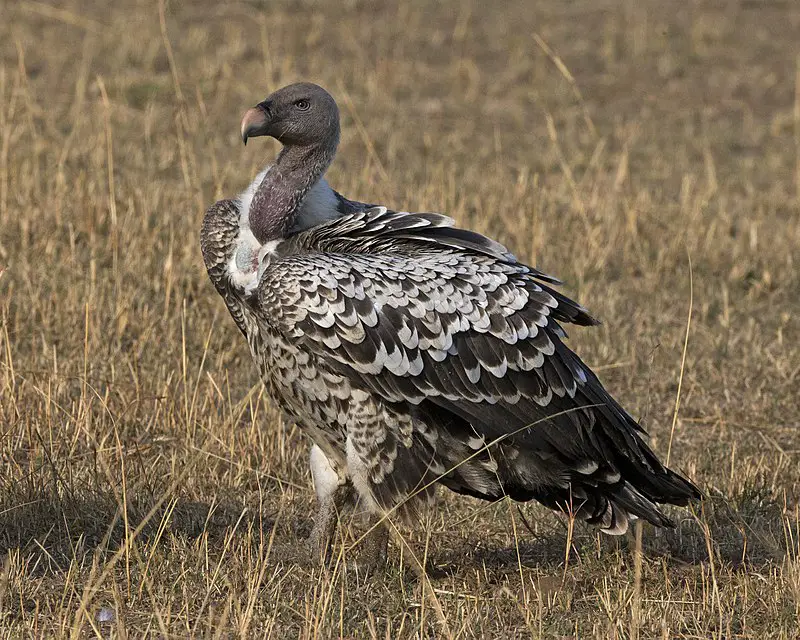
Rüppell’s vulture is a large bird of prey native to the Sahel region and East Africa, named after Eduard Rüppell.
It has a current population of around 22,000, but its numbers are decreasing due to loss of habitat, accidental poisoning and other factors.
This species can be identified by their dark brown bodies with white patches on their wings and black feathers at the base of their neck that form an “M” pattern.
They have greyish-white heads with yellow eyes surrounded by bare skin coloured pink or red, depending upon age/sex.
Their strong feet enable them to hold onto food while they tear it apart using powerful hooked beaks, which also help them scavenge for carrion in open grasslands or savanna habitats where they primarily feed off dead animals.
Scientific classification:
| Kingdom | Animalia |
| Phylum | Chordata |
| Class | Aves |
| Order | Accipitriformes |
| Family | Accipitridae |
| Genus | Gyps |
| Species | G. rueppelli |
Also Featured In: Common Kenyan Birds, East African Birds
20. Andean Condor
The Andean condor is a giant South American Cathartid vulture and its only genus member.
Found in the Andes mountains and along Pacific coasts, it is thought to be the largest flying bird on Earth by weight and wingspan, with a maximum wingspan reaching up to 10 feet 10 inches (3.3 m) and weighing 33 lbs (15 kg).
It has mainly black plumage, which helps keep it warm at high altitudes, while white patches adorn its head, neck, and chest, as well as underwing coverts.
Its powerful bill allows it to consume carrion efficiently while also being able to crack bones for nutrition when necessary.
The amazing flight capabilities of this majestic creature allow them to soar through air thermals effortlessly, making them an impressive sight against clear blue skies.
Scientific classification:
| Kingdom | Animalia |
| Phylum | Chordata |
| Class | Aves |
| Order | Accipitriformes |
| Family | Cathartidae |
| Genus | Vultur Linnaeus, 1758 |
| Species | V. gryphus |
Also Featured In: Common Birds in Colombia, Aviary Birds You Should Know
21. European Bee-Eater
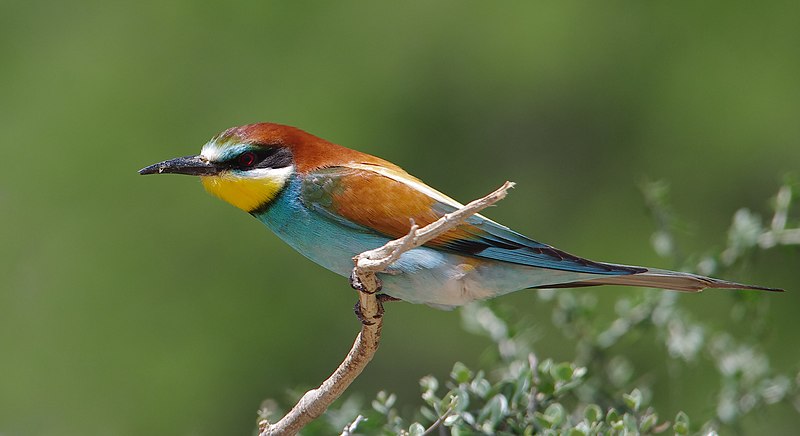
The European Bee-Eater is a stunningly beautiful bird boasting an array of bright colours. Its head and neck are light blue with greenish ear coverts and its back is chestnut brown.
The wings have yellow primaries bordered in black, while the rest of the feathers contain hues of pink, russet orange, greyish-blue and olive green.
This species can be found breeding throughout Southern Europe to Central Asia as well as Northern Africa to South Africa, where it likes to inhabit open country near rivers or streams with bare banks for nesting purposes.
It migrates during winter months down into tropical areas within both Africa and India but will occasionally overshoot northwards, which may result in rare sightings elsewhere on occasion too.
Scientific classification:
| Kingdom | Animalia |
| Phylum | Chordata |
| Class | Aves |
| Order | Coraciiformes |
| Family | Meropidae |
| Genus | Merops |
| Species | M. apiaster |
Also Featured In: Birds of Poland, Birds Found in Hungary
22. Cardinal
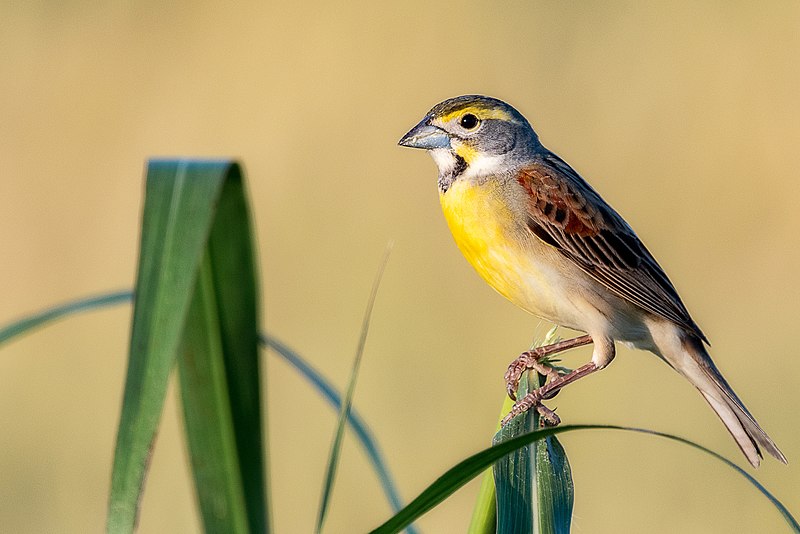
Cardinalidae is a family of passerine birds endemic to the New World, including cardinals, grosbeaks and buntings. This large group has great diversity in its members, ranging from tanager-like Piranga to warbler-like Granatellus.
They are usually distinguished by their bright plumage, with reds, oranges and yellows being common among them.
Their strong bills enable them to feed on seeds, fruits, insects, and other small prey items like lizards or frogs, depending upon species.
Cardinals also have loud calls often used for territorial defence and courtship purposes, while some can even imitate sounds made by other animals.
These adaptable birds inhabit various habitats across North America, making them an important part of many ecosystems there.
Scientific classification:
| Kingdom | Animalia |
| Phylum | Chordata |
| Class | Aves |
| Order | Passeriformes |
| Superfamily | Emberizoidea |
| Family | Cardinalidae Ridgway, 1901 |
Also Featured In: Common Birds in Canada, Most Common Songs Birds that Live around You
23. Great Blue Heron
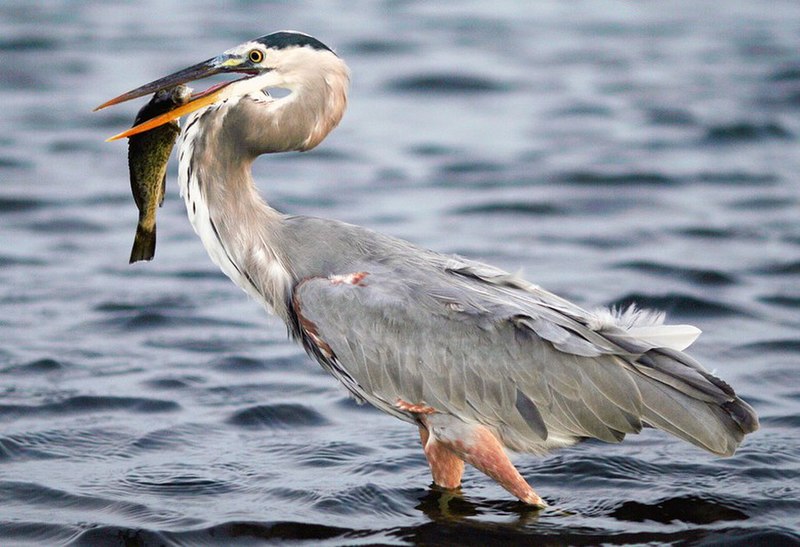
The Great Blue Heron is a majestic wading bird found in many parts of North America, Central America, the Caribbean and even as far away as the Galapagos Islands.
It has an impressive wingspan which can reach up to six feet wide. Its feathers are mainly bluish-grey with brownish streaks on both its neck and chest, while its head displays white plumes. The adult herons can also be identified by their yellow bill and legs.
They live near bodies of water such as lakes, marshes or rivers, feeding on fish using a spear-like motion with their sharp bills.
An all-white population exists only in South Florida and the Florida Keys, making it quite unique.
Scientific classification:
| Kingdom | Animalia |
| Phylum | Chordata |
| Class | Aves |
| Order | Pelecaniformes |
| Family | Ardeidae |
| Genus | Ardea |
| Species | A. herodias |
Also Featured In: Blue Birds You’ll Found around Us, Birds Commonly Found in New York
24. Sociable Lapwing
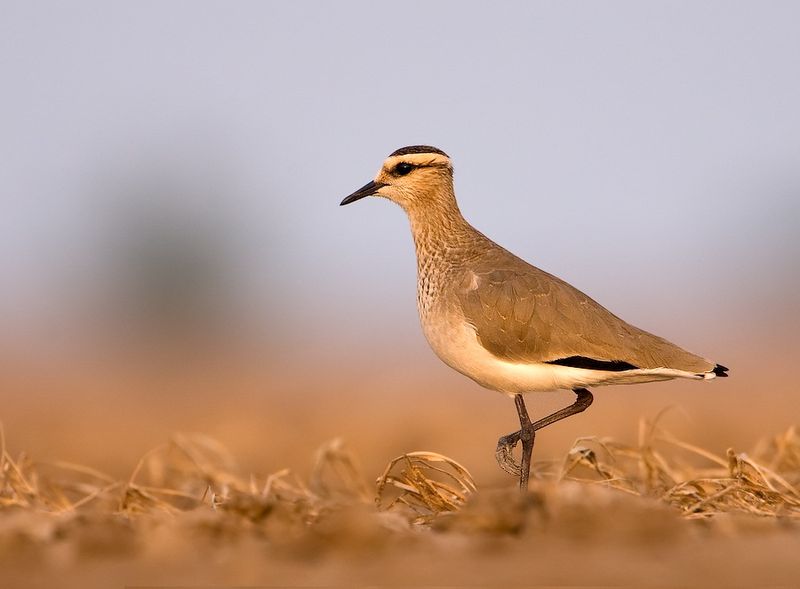
The Sociable Lapwing is an impressive wading bird of the plover family. It breeds in Kazakhstan and migrates to spend its winter months in areas such as the Middle East, Indian Subcontinent, and Sudan.
Historically known as Black-bellied lapwing due to its black lower body feathers that contrast with white upper parts, it has a unique social behaviour which earned it the name ‘Sociable’.
This species often gathers together in large flocks during migration but also forms smaller groups while breeding or searching for food.
The male’s courtship display involves making loud calls from high places like rocks before diving down onto his chosen mate.
These birds are protected under international law since they have been hunted almost to extinction for their meat and feathers over the past centuries.
Scientific classification:
| Kingdom | Animalia |
| Phylum | Chordata |
| Class | Aves |
| Order | Charadriiformes |
| Family | Charadriidae |
| Genus | Vanellus |
| Species | V. gregarius |
Also Featured In: Common Birds in Saudi Arabian, Native Birds of Kazakhstan
25. Black Skimmer
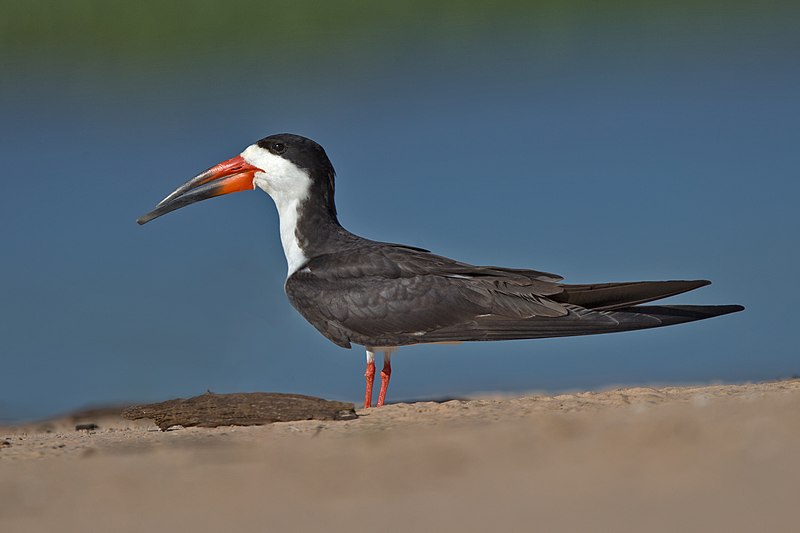
The Black Skimmer is a seabird which belongs to the skimmer genus Rynchops and Laridae family.
It breeds in North and South America, while Northern populations migrate south for winter towards warmer climates such as the Caribbean or Pacific coasts.
The Southern American races have adapted to annual floods by migrating shorter during this time.
These birds are easily identified by their unique long red bill with an upper mandible longer than its lower mandible.
They feed mainly on small fish caught at night when they skim across shallow water using their beak like a knife cutting through waves of water.
Their dark grey back contrasts against white belly feathers, creating beautiful patterns in flight, aiding them in catching prey easier due to their camouflage effect above and below the water’s surface.
Scientific classification:
| Kingdom | Animalia |
| Phylum | Chordata |
| Class | Aves |
| Order | Charadriiformes |
| Family | Laridae |
| Genus | Rynchops |
| Species | R. niger |
Also Featured In: Most Unique Birds in Peru, Birds You’ll Find in South Texas
26. Parrots
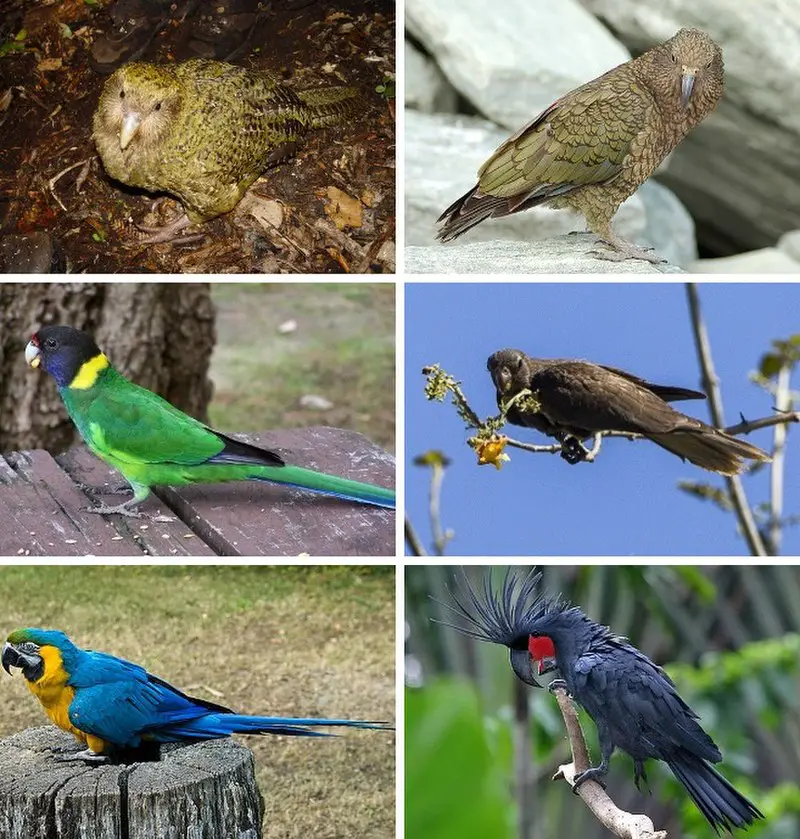
Parrots are a diverse group of birds found in tropical and subtropical regions. They make up the order Psittaciformes, which is divided into three superfamilies: “true” parrots (Psittacoidea), cockatoos (Cacatuoidea) and New Zealand Parrots (Strigopoidea).
Many species have brightly coloured feathers that can be red, yellow or blue. Their strong curved bills allow them to feed on fruits, nuts and seeds.
Parrot behaviour ranges from playful to aggressive depending on their environment and socialization with humans.
Some even learn human words. As beloved pets, they bring joy to many households worldwide, though it’s important for owners to understand how best to care for these intelligent creatures so as not to cause distress or harm.
Scientific classification:
| Kingdom | Animalia |
| Phylum | Chordata |
| Class | Aves |
| Clade | Psittacopasserae |
| Order | Psittaciformes Wagler, 1830 |
Also Featured In: Most common birds in Australia, Birds That Live in the Jungle
27. Pelican
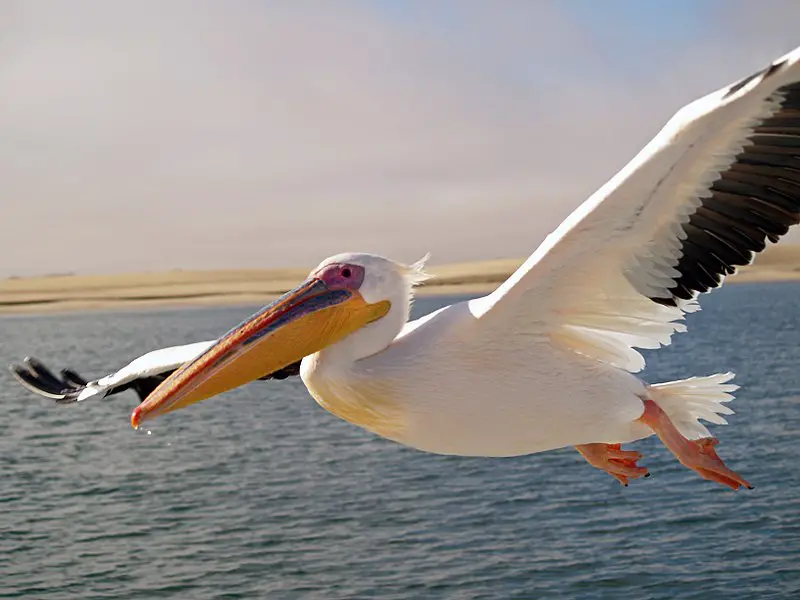
Pelicans are large water birds and form part of the family Pelecanidae. They have long beaks, allowing them to scoop up prey from both land and sea easily.
Their most distinctive feature is their huge throat pouch, which they drain water before swallowing their food.
Most pelican species have predominantly pale plumage; however, exceptions, such as the brown and Peruvian pelicans, exhibit darker colouring.
The bill, face skin and pouch of all Pelican species become brightly coloured during the breeding season in order to attract mates.
Pelicans can often live up to 25 years because they eat mostly fish, providing enough nutrients for longevity.
Scientific classification:
| Kingdom | Animalia |
| Phylum | Chordata |
| Class | Aves |
| Order | Pelecaniformes |
| Family | Pelecanidae |
| Genus | Pelecanus Linnaeus, 1758 |
Also Featured In: Birds that Live in the Ocean , Sydney Birds You Need to See
28. Common Tern
The Common Tern is a seabird in the Laridae family, found all over Europe, Asia and North America. It is migratory, spending its winters in coastal tropical and subtropical regions.
Breeding adults have light grey upperparts with white to very light grey underparts featuring an orange-red beak and black cap.
They are known for their graceful flight as they hunt small fish or insects by diving into water from great heights.
During the breeding season, they build nests together on islands or sandbars using grasses and other materials to create them.
The female will lay two eggs, which she incubates while her mate stands guard nearby; both parents take turns feeding the chicks until it’s time for them to fly away.
Scientific classification:
| Kingdom | Animalia |
| Phylum | Chordata |
| Class | Aves |
| Order | Charadriiformes |
| Family | Laridae |
| Genus | Sterna |
| Species | S. hirundo |
Also Featured In: Birds of Netherlands, Common Birds Found near Robert Island
29. Common House Martin
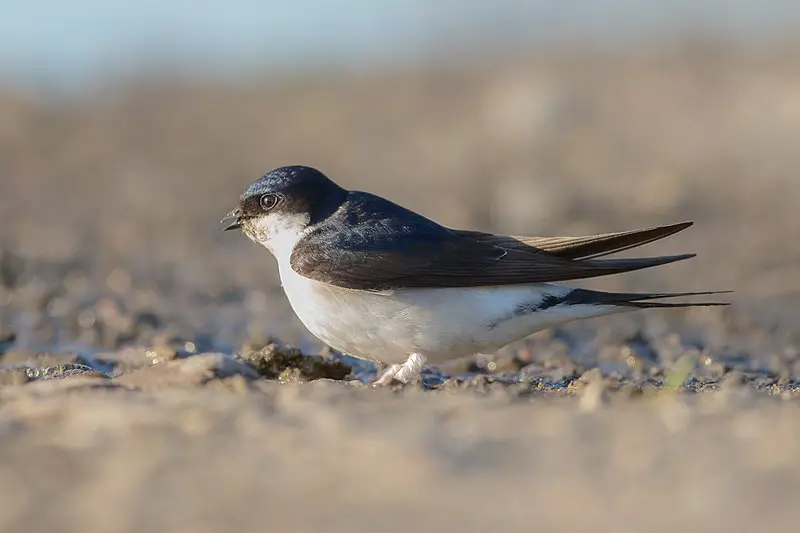
The Common House Martin is a beautiful migratory bird of the swallow family. It breeds in Europe, North Africa, and the Palearctic region, then winters in sub-Saharan Africa and tropical Asia.
This species feeds on insects caught while flying through its habitat.
Its main food source changes depending on where it is located at any given time as it follows warmer climates with more abundance of flies during winter months when migrating southward from its breeding grounds up north.
The house martin has an unmistakable appearance; they have glossy blue upperparts and white underparts that contrast beautifully against their black wingspan, which can reach up to 18 cm long.
Scientific classification:
| Kingdom | Animalia |
| Phylum | Chordata |
| Class | Aves |
| Order | Passeriformes |
| Family | Hirundinidae |
| Genus | Delichon |
| Species | D. urbicum |
Also Featured In: Most Beautiful birds of Greece, Common Birds in the Cities
30. Black-Crowned Night Heron
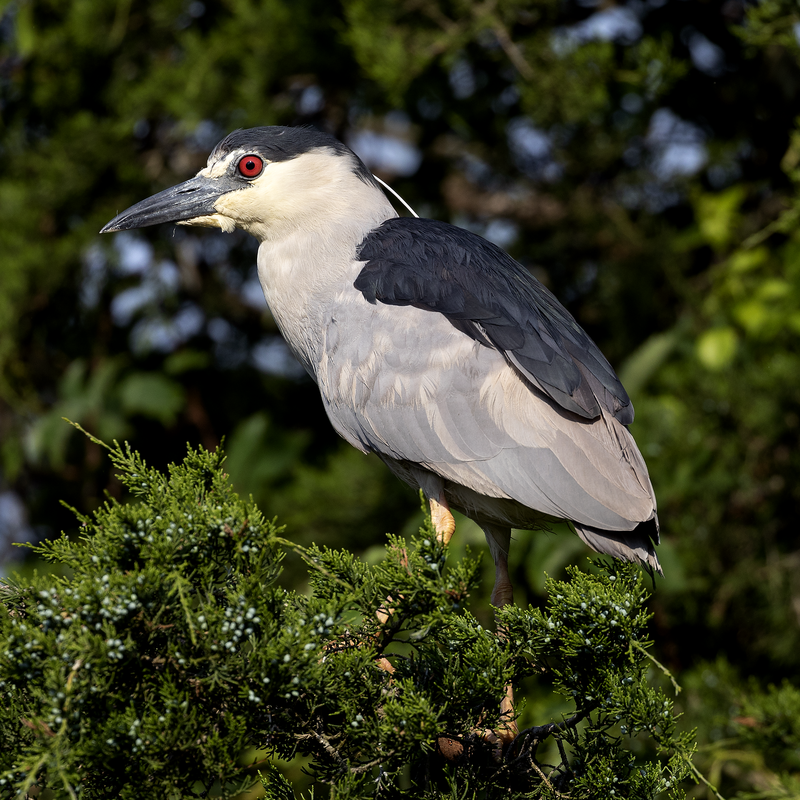
The Black-crowned night heron (Nycticorax nycticorax) is a medium-sized bird found in various parts of the world, including Europe, Asia and North and South America.
It has black crowns on its head with white feathers underneath. Its wings are greyish brown, while its underparts are mostly white.
This species can be seen foraging near shallow water or along coastlines during dusk or dawn as it hunts small fish, amphibians and crustaceans.
They also feed on insects such as grasshoppers and beetles, which they find in meadows close to freshwater bodies like lakes or ponds, where they breed during springtime, making nests using twigs lined with reeds and leaves near these waterside habitats.
In Australasia, this species hybridizes with the nankeen night heron that inhabits those areas instead; however, both populations remain distinct from each other despite their overlapping range regions.
Scientific classification:
| Kingdom | Animalia |
| Phylum | Chordata |
| Class | Aves |
| Order | Pelecaniformes |
| Family | Ardeidae |
| Genus | Nycticorax |
| Species | N. nycticorax |
Also Featured In: Common Birds Found in Switzerland, Birds of Kauai, Hawaii
31. Grey-Headed Lapwing
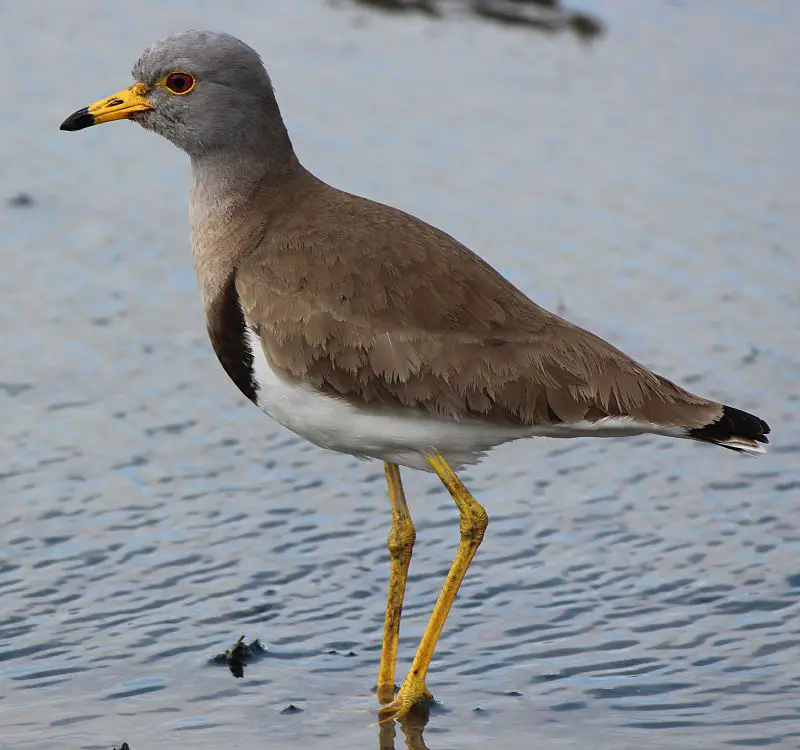
The Grey-headed Lapwing is a bird native to northeast China and Japan. During the winter season, they migrate from India to northern Southeast Asia all the way down to Cambodia.
The Japanese population has been known to spend some of their time in southern Honshū during this period as well.
It’s also classed as a vagrant species in several other countries, such as Russia, the Philippines, Indonesia, Australia and Sri Lanka.
This lovely little lapwing has grey feathers on its head and white around its face and neck area, making it easy for people to identify it if spotted out in nature.
They feed mainly off insects but have occasionally been seen eating plants or small seeds now and then, too.
Scientific classification:
| Kingdom | Animalia |
| Phylum | Chordata |
| Class | Aves |
| Order | Charadriiformes |
| Family | Charadriidae |
| Genus | Vanellus |
| Species | V. cinereus |
Also Featured In: Singapore Birds, Common Birds that Live in Odisha
32. Roseate Spoonbill
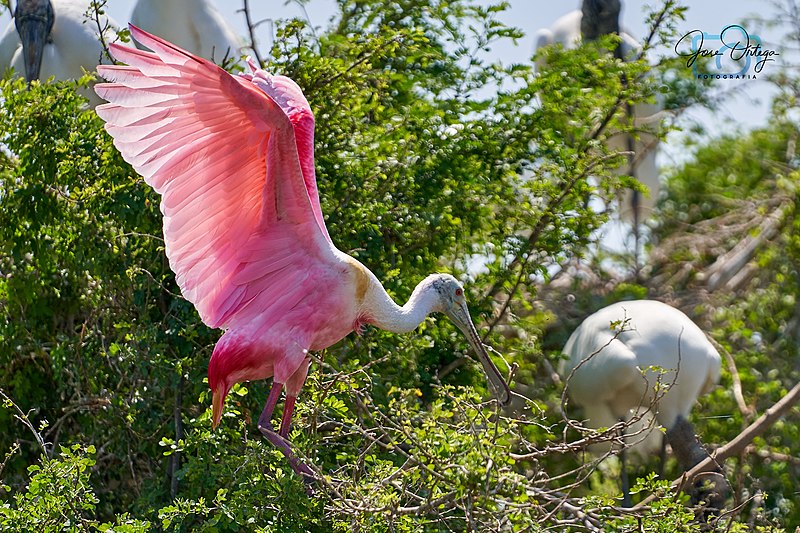
The Roseate Spoonbill is a beautiful and majestic bird in North and South America.
It belongs to the ibis family, Threskiornithidae, and its vibrant pink colour comes from canthaxanthin pigment derived from their diet of crustaceans like shrimp.
Sadly, plume hunting almost drove this species close to extinction during the 18th and 19th centuries, but fortunately, it’s coming back due to conservation efforts made by dedicated wildlife organisations.
Its large spoon-like bill helps them filter out food sources such as small fish or frogs from shallow water areas while they wade through mudflats with their long legs looking for something tasty.
With its unique appearance, graceful wingspan, and impressive flight capabilities, the Roseate Spoonbill is an incredibly photogenic animal that will captivate any viewer’s attention who happens to be lucky enough to witness it in all its glory.
Scientific classification:
| Kingdom | Animalia |
| Phylum | Chordata |
| Class | Aves |
| Order | Pelecaniformes |
| Family | Threskiornithidae |
| Genus | Platalea |
| Species | P. ajaja |
Also Featured In: Costa Rica Birds, Everglades Birds
33. Red-Breasted Merganser
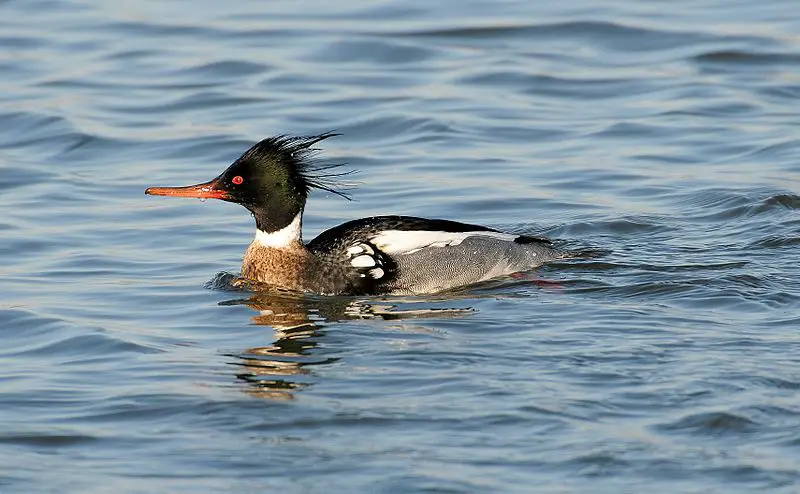
The Red-breasted merganser is a diving duck, part of the sawbills family. It was first described in 1758 by Carl Linnaeus with its Latin name “Mergus Serrator”, meaning sawyer or cutter.
With their red breast feathers and blackheads, these birds are easy to spot when they’re near water bodies such as lakes and rivers hunting for fish.
They also feed on crustaceans and molluscs that they catch underwater.
During breeding season, the males develop white patches around their eyes, making them even more distinct from other duck species.
The Red-breasted Mergansers’ population numbers have been declining over recent years due to habitat loss caused by human activities like construction projects close to wetlands where these birds live, but conservation efforts can help protect this majestic bird’s future generations.
Scientific classification:
| Kingdom | Animalia |
| Phylum | Chordata |
| Class | Aves |
| Order | Anseriformes |
| Family | Anatidae |
| Genus | Mergus |
| Species | M. serrator |
Also Featured In: Kuwait Birds, Common Birds of West Caicos
34. Common Shelduck
The Common Shelduck is a species of waterfowl belonging to the shelduck genus Tadorna. It can be found in temperate and subtropical regions across the Euro-Siberian region of the Palearctic.
During winter months, it also ventures into the Maghreb. Fossil bones discovered from Dorkovo (Bulgaria) are also believed to belong to this bird’s species – Balcanas pliocaenica.
The Common Shelduck has a large body with short legs and wings that enable it to have powerful flight capabilities during migratory seasons, along with long bills perfect for digging up food sources such as molluscs or aquatic vegetation habits
These birds have adapted over time in wetland habitats, making them an essential part of many ecosystems around Europe and Asia.
Scientific classification:
| Kingdom | Animalia |
| Phylum | Chordata |
| Class | Aves |
| Order | Anseriformes |
| Family | Anatidae |
| Genus | Tadorna |
| Species | T. tadorna |
35. Wandering Albatross
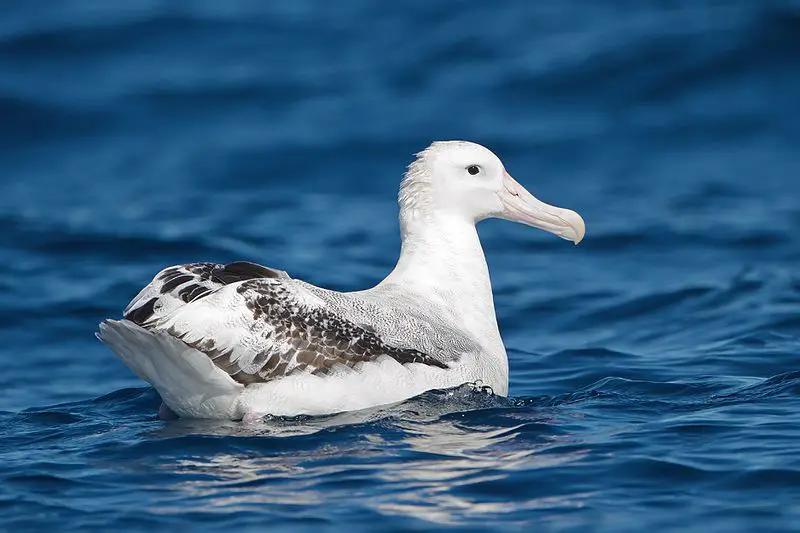
The Wandering Albatross is a large seabird from the family Diomedeidae found in the Southern Ocean. It has white wings, black tips and a long hooked bill.
With an impressive wingspan of up to 3m, they are one of the largest birds that can fly.
They spend most of their lives far out at sea, only coming to land for the breeding season on remote islands where they nest on cliffs or rocky areas close to the ocean.
The species was first described in 1783 but had been considered similar to other albatrosses, such as Tristan Albatross and Antipodean Albatross, until recently when it was recognized as an individual species due to genetic studies showing differences between them.
Scientific classification:
| Kingdom | Animalia |
| Phylum | Chordata |
| Class | Aves |
| Order | Procellariiformes |
| Family | Diomedeidae |
| Genus | Diomedea |
| Species | D. exulans |
Also Featured In: Antarctica Birds, Patagonia Birds You Should Know
36. Yellow-Crowned Night Heron
The Yellow-crowned night heron is a beautiful and unique bird species native to the Americas. It has distinctive yellow crowns on its head, making it easy to identify among other herons.
These birds are also larger than most other types of herons, reaching up to 70 cm in length and 850 g in weight.
They usually feed on small fish or crustaceans while wading through shallow waters with their long legs.
The yellow-crowned night heron can be found near marshes or lakes during breeding season when they build nests made from twigs high above the ground to protect against predators like raccoons and foxes.
This majestic bird is an important part of wetland ecosystems as it helps balance populations of smaller aquatic animals by preying upon them.
Scientific classification:
| Kingdom | Animalia |
| Phylum | Chordata |
| Class | Aves |
| Order | Pelecaniformes |
| Family | Ardeidae |
| Genus | Nyctanassa |
| Species | N. violacea |
Also Featured In: Bermuda birds, Common Central Park Birds
37. Yellow-Legged Gull
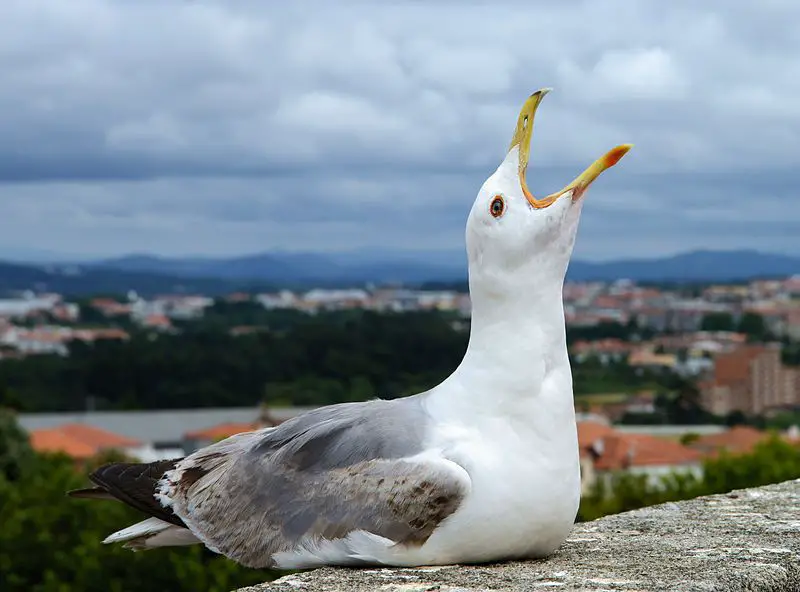
The Yellow-legged Gull is a large bird found mainly in Europe, the Middle East and North Africa.
It was previously considered to be either a subspecies of the Caspian gull or Herring Gull but has recently been identified as its own species. The name Larus comes from Latin and likely refers to seabirds in general.
This species has yellow legs, a white head with dark eyespots on each side, grey wings with black tips and pinkish legs.
They have curved bills that are yellow at the base, which turn red near the tip during the breeding season.
These birds feed mainly on fish but also scavenge for necessary food, such as insects, crustaceans, etc. The Yellow-legged Gull can often be seen along coastlines soaring high above fishing boats, searching for their next meal.
Scientific classification:
| Kingdom | Animalia |
| Phylum | Chordata |
| Class | Aves |
| Order | Charadriiformes |
| Family | Laridae |
| Genus | Larus |
| Species | L. michahellis |
Also Featured In: Gulls Species, Amsterdam Birds You Should Know
38. Caspian Gull
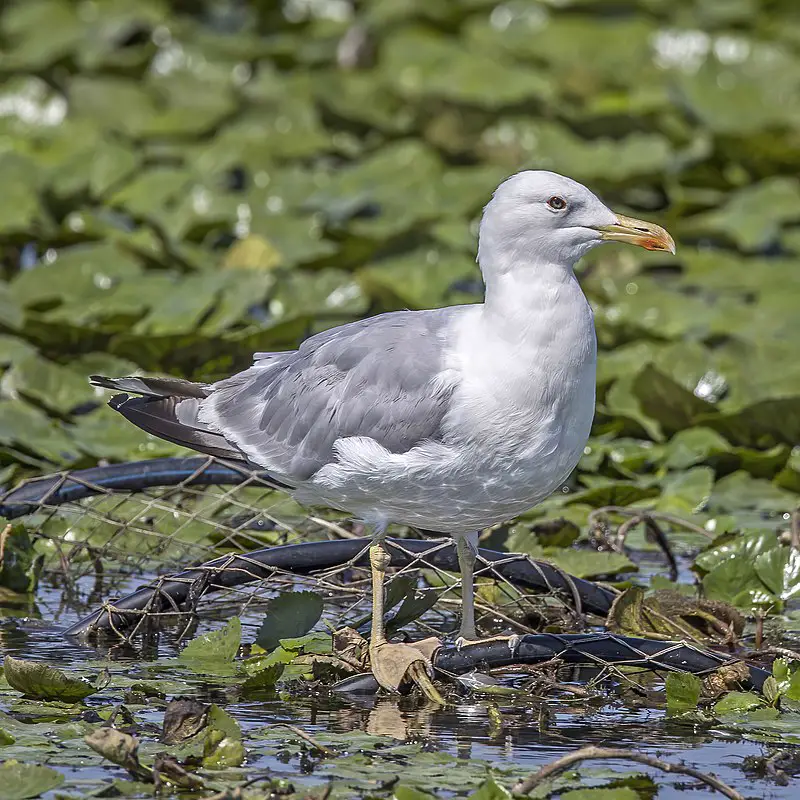
The Caspian gull is a large species of seabird found in the herring and lesser black-backed gull complex. It has a Latin name, Larus cachinnans, which translates to ‘laughing’ from its habit of making loud noises when interacting with other birds.
It measures 56–68 cm long and has an impressive wingspan ranging from 137 to 155 cm wide. Its body mass can range between 680–1 kg depending on its age and gender.
This bird generally lives near coastlines as it feeds mainly off fish caught in shallow waters or scavenged food sources such as garbage dumps; however, it will also inhabit freshwater areas during the breeding season for protection against predators.
All these features make the Caspian Gull one beautiful yet powerful seabird.
Scientific classification:
| Kingdom | Animalia |
| Phylum | Chordata |
| Class | Aves |
| Order | Charadriiformes |
| Family | Laridae |
| Genus | Larus |
| Species | L. cachinnans |
39. Great Grey Owl
The Great Grey Owl is the world’s largest owl species and is found across the Northern Hemisphere. It has many other names, such as Phantom of The North, Cinereous Owl, Spectral Owl and Lapland Owl.
This majestic bird stands at an impressive length of about 24 inches with a wingspan reaching up to five feet.
Its unique plumage allows it to blend in well with its natural environment, making spotting this elusive creature difficult.
Despite being generally silent during most times, they are known for their deep hooting calls when mating or roosting season arrives.
These magnificent birds feed on small mammals like mice, voles and hares but have also been seen hunting larger prey such as ducks and grouse, depending upon availability in their area.
Scientific classification:
| Kingdom | Animalia |
| Phylum | Chordata |
| Class | Aves |
| Order | Strigiformes |
| Family | Strigidae |
| Genus | Strix |
| Species | S. nebulosa |
Also Featured In: Owls Species, Common Estonian Birds
40. Sand Martin
The sand martin, also known as the bank swallow or collared sand martin, is a migratory bird belonging to the swallow family.
It has an extensive summer range that covers most of Europe and other parts of the Palearctic region, such as North America.
It can be found in tropical Africa and India during the winter season. The length of this small passerine bird varies from 12-14 cm, with a wingspan stretching up to 24 cm long.
Its back feathers are brownish grey, while its belly is white in colour with dark streaks on the sides.
Sand Martins feed mainly on flying insects, which they catch during their flight along rivers or over wetlands, using their swift flight abilities at low altitudes to forage food items like flies and mosquitoes midair.
Scientific classification:
| Kingdom | Animalia |
| Phylum | Chordata |
| Class | Aves |
| Order | Passeriformes |
| Family | Hirundinidae |
| Genus | Riparia |
| Species | R. riparia |
Also Featured In: Swallows Species, Turkey Birds You Should Know
41. Willow Ptarmigan
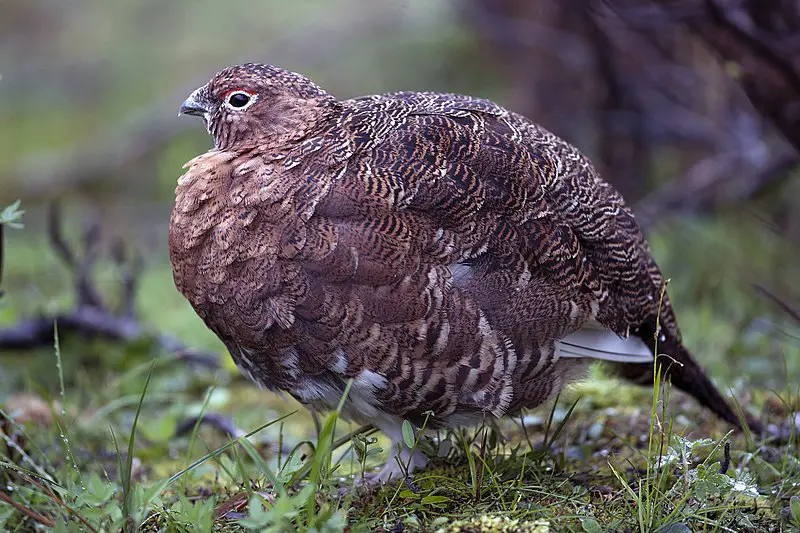
The Willow Ptarmigan is a bird belonging to the grouse family, Phasianidae. It can be found in northern Europe, particularly birch and other forests or moorlands regions of Scandinavia and Ireland.
The subspecies L. l. scotia was once considered its own species, known as Red Grouse.
They are characterized by their red-brown plumage that changes with the seasons; during winter, they grow white feathers for camouflage against snow cover, while in springtime, these change back to brownish tones for better blending into vegetation.
In general, this type of ptarmigan tends to live in flocks on open grounds where it feeds on buds and leaves from shrubs like willows, heathers and birches, among others, as well as insects when available .
Scientific classification:
| Kingdom | Animalia |
| Phylum | Chordata |
| Class | Aves |
| Order | Galliformes |
| Family | Phasianidae |
| Genus | Lagopus |
| Species | L. lagopus |
Also Featured In: Alaska Birds, Willows Birds Around You
42. Columbidae
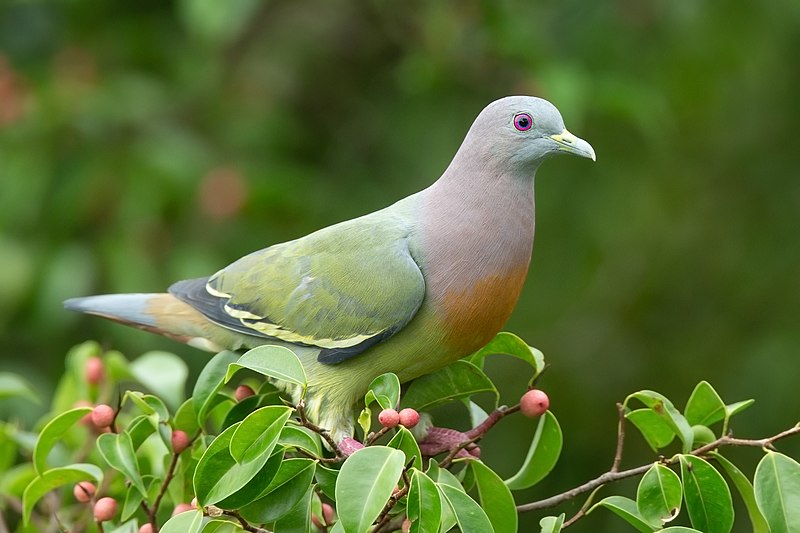
Columbidae is a bird family that includes both doves and pigeons. These birds are characterized by their stout bodies, short necks, and small, slender bills with fleshy ceres in some species.
They feed mainly on seeds, fruits, and plants found worldwide but have the greatest variety in the Indomalayan and Australasian regions.
Columbidae have an unmistakable soft cooing sound, making them one of the most beloved avian families worldwide – especially among city dwellers.
Whether it be feeding time or just hearing their soothing call throughout nature walks, these birds will remain favourites for many years.
Scientific classification:
| Kingdom | Animalia |
| Phylum | Chordata |
| Class | Aves |
| Clade | Columbimorphae |
| Order | Columbiformes Latham, 1790 |
| Family | Columbidae Leach, 1820 |
Also Featured In: birds of white, Birds for Your Home Garden
43. Brown Pelican
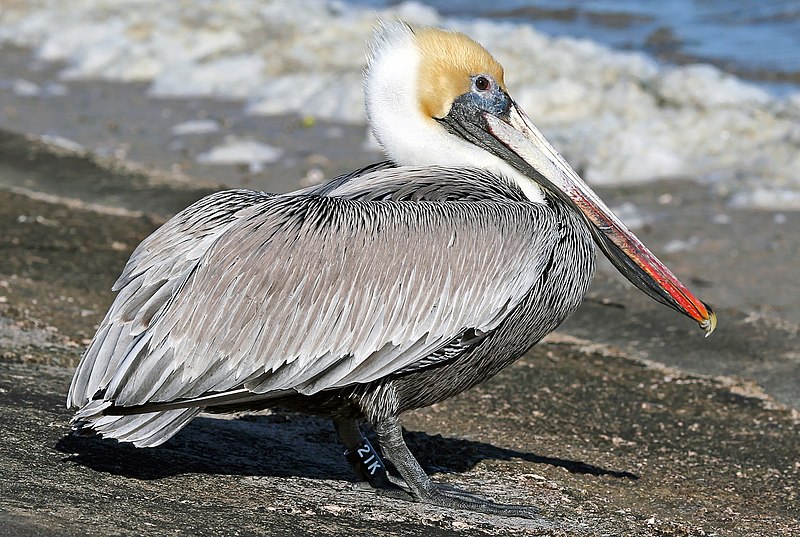
The majestic brown pelican is a dive-feeding bird that belongs to the pelican family. It is one of the three pelican species found in the Americas and is known to dive into water to catch its prey.
This bird can be found from the Atlantic Coast of New Jersey to the mouth of the Amazon River, along the Pacific Coast from British Columbia to northern Chile, including the Galapagos Islands.
Its scientific name is Pelecanus occidentalis, and it has a coloured brown plumage, which is its distinct characteristic.
The brown pelican belongs to the largest bird species that exists today, with a wingspan that can stretch up to seven feet long.
This bird helps maintain a balance in the ecosystem by eating smaller fish, crustaceans, and other aquatic prey.
Scientific classification:
| Kingdom | Animalia |
| Phylum | Chordata |
| Class | Aves |
| Order | Pelecaniformes |
| Family | Pelecanidae |
| Genus | Pelecanus |
| Species | P. occidentalis |
Also Featured In: Birds You’ll Find in the Sea, Water Birds Live around Us
44. Common Merganser
The Common merganser, also known as the goosander in Eurasia, is a notable seaduck found in river and lake habitats of forested regions across Europe, Asia, and North America.
This large bird primarily feeds on fish and is known for nesting in tree holes. Carl Linnaeus first described it in 1758 in the 10th edition of his Systema Naturae.
With its distinctive appearance and adaptability, the Common merganser is a fascinating species that has captured the attention of bird watchers and ornithologists alike.
Scientific classification:
| Kingdom | Animalia |
| Phylum | Chordata |
| Class | Aves |
| Order | Anseriformes |
| Family | Anatidae |
| Genus | Mergus |
| Species | M. merganser |
Also Featured In: Birds Commonly Found in Northern California, Most Common Lake Birds
45. Owls
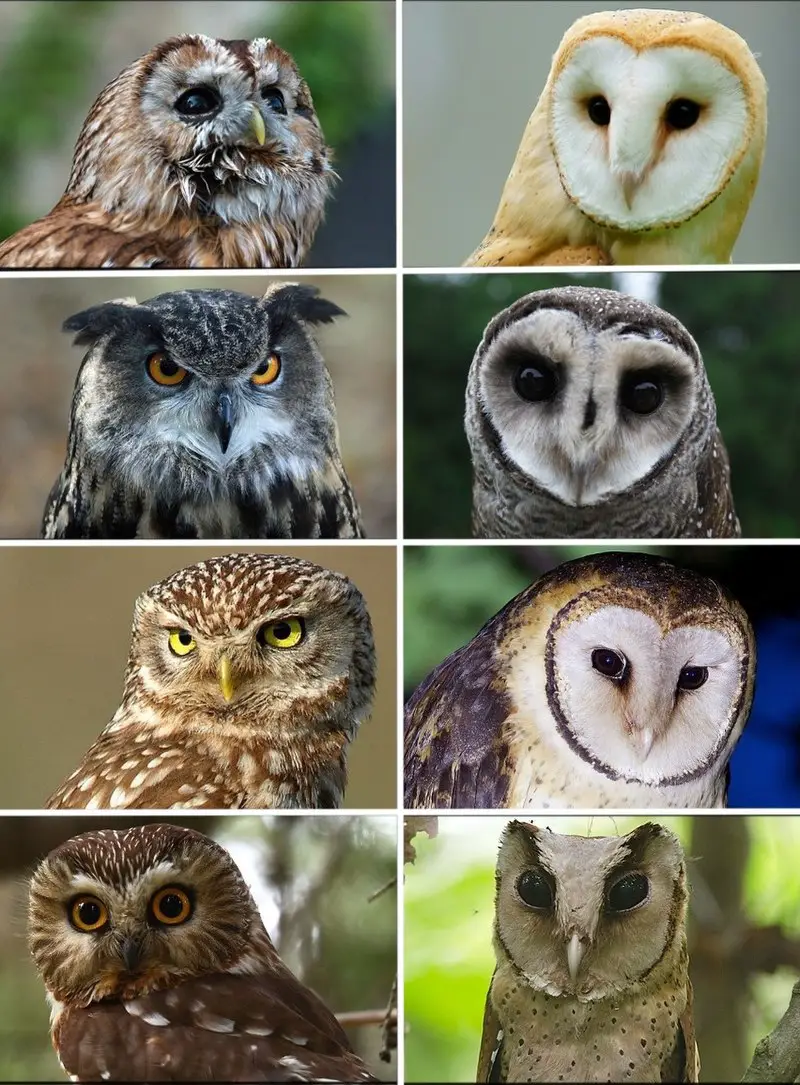
Owls are remarkable birds of prey that belong to the order Strigiformes. Known for their solitary and nocturnal behaviour, these birds are commonly associated with an upright stance, broad head, binocular vision, binaural hearing, sharp talons, and specially adapted feathers for silent flight.
With over 200 species, owls are mostly carnivorous and hunt small mammals, making them excellent at controlling rodent populations.
Although most owls are solitary animals, some species, such as the gregarious burrowing owl, are social and interact regularly with their own kind.
Despite their nocturnal habits, some owls, like the northern hawk owl, are diurnal and hunt during daylight hours.
All in all, owls are fascinating creatures that have intrigued bird watchers and scientists alike for many years.
Scientific classification:
| Kingdom | Animalia |
| Phylum | Chordata |
| Class | Aves |
| Clade | Telluraves |
| Order | Strigiformes Wagler, 1830 |
Also Featured In: Famous Paintings Birds, Birds You’ll Find in Zoo
46. Water Pipit
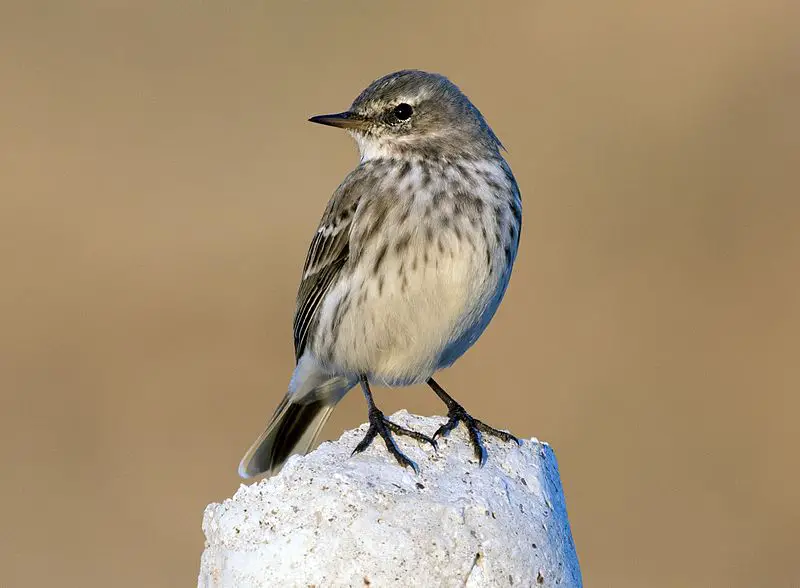
The water pipit is a small bird that breeds in the mountains from Europe to China. It is a migrant moving to lower altitudes or wet lowlands in winter.
The bird has greyish-brown upperparts, faintly streaked with darker brown and pink-buff underparts that fade to white.
It is a passerine bird, meaning it perches on trees and sings using its strong voice. This species is also known for its short beak and long legs, allowing it to hop through rocky terrain and shallow water.
The water pipit is an important indicator of environmental health, as it requires wetlands and clean water sources to survive.
Despite this, the bird is currently listed as a species of least concern, with stable populations throughout its range.
Scientific classification:
| Kingdom | Animalia |
| Phylum | Chordata |
| Class | Aves |
| Order | Passeriformes |
| Family | Motacillidae |
| Genus | Anthus |
| Species | A. spinoletta |
Also Featured In: Common Slovakian Birds, Autumn Birds You Should Know
47. Northern Wheatear
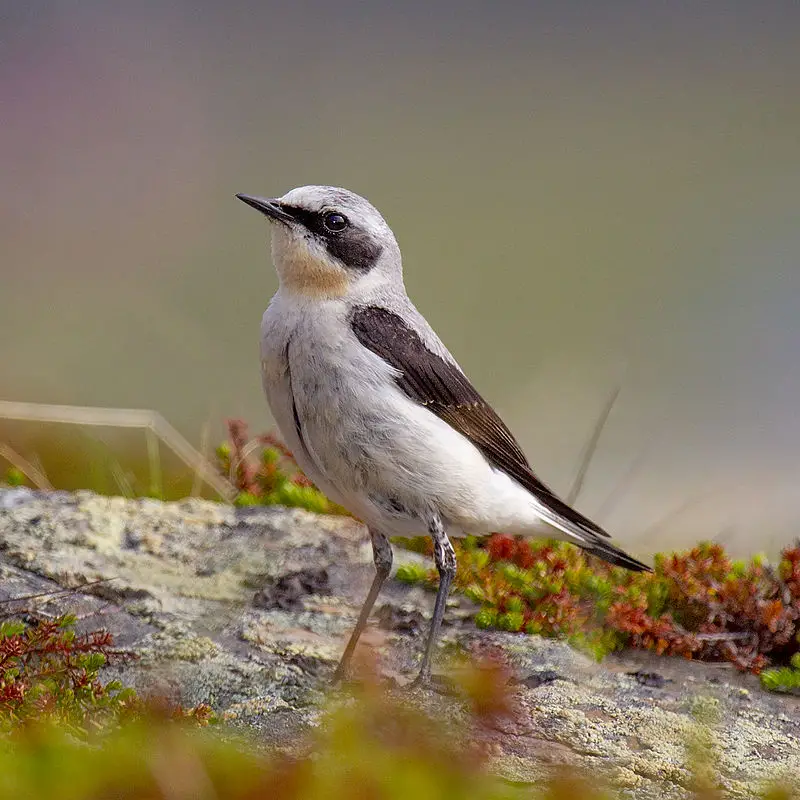
The Northern Wheatear is a small migratory bird found in Europe and North and Central Asia. Formerly classified as a member of the thrush family, it is now considered an Old World flycatcher.
These insectivorous birds breed during the summer months and migrate long distances during winter.
They are the most widespread of the Oenanthe wheatear genus. They are easy to identify with distinctive black and white markings and a slender body.
The Northern Wheatear is known for its acrobatic ability, often seen catching insects mid-air. Males often have striking blue-grey wings and a slate-blue head, while females have brown plumage with a slight peach hue.
Their migration patterns have made them a popular bird for birdwatchers, with sightings occurring in various countries such as Iceland, the UK, and Russia.
Scientific classification:
| Kingdom | Animalia |
| Phylum | Chordata |
| Class | Aves |
| Order | Passeriformes |
| Family | Muscicapidae |
| Genus | Oenanthe |
| Species | O. oenanthe |
Also Featured In: Shetland Islands Birds You Should Know, Birds that Live in Greenland
48. Pipits
Pipits are small, ground-feeding birds that belong to the genus Anthus. They have medium to long tails and are often drab in appearance. Pipits are found worldwide except in the driest deserts, rainforests, and mainland Antarctica.
They are part of the family Motacillidae, which also includes wagtails and longclaws. These insectivorous birds have slender bodies and are adapted to living in open countryside.
They feed primarily on insects found on the ground. With a cosmopolitan distribution, pipits are well-suited to living in different kinds of habitats worldwide.
Their ability to thrive in various environments is a testament to their adaptability and hardy nature. Overall, pipits are fascinating birds that are worth learning more about.
Scientific classification:
| Kingdom | Animalia |
| Phylum | Chordata |
| Class | Aves |
| Order | Passeriformes |
| Family | Motacillidae |
| Genus | Anthus Bechstein, 1805 |
49. Smew
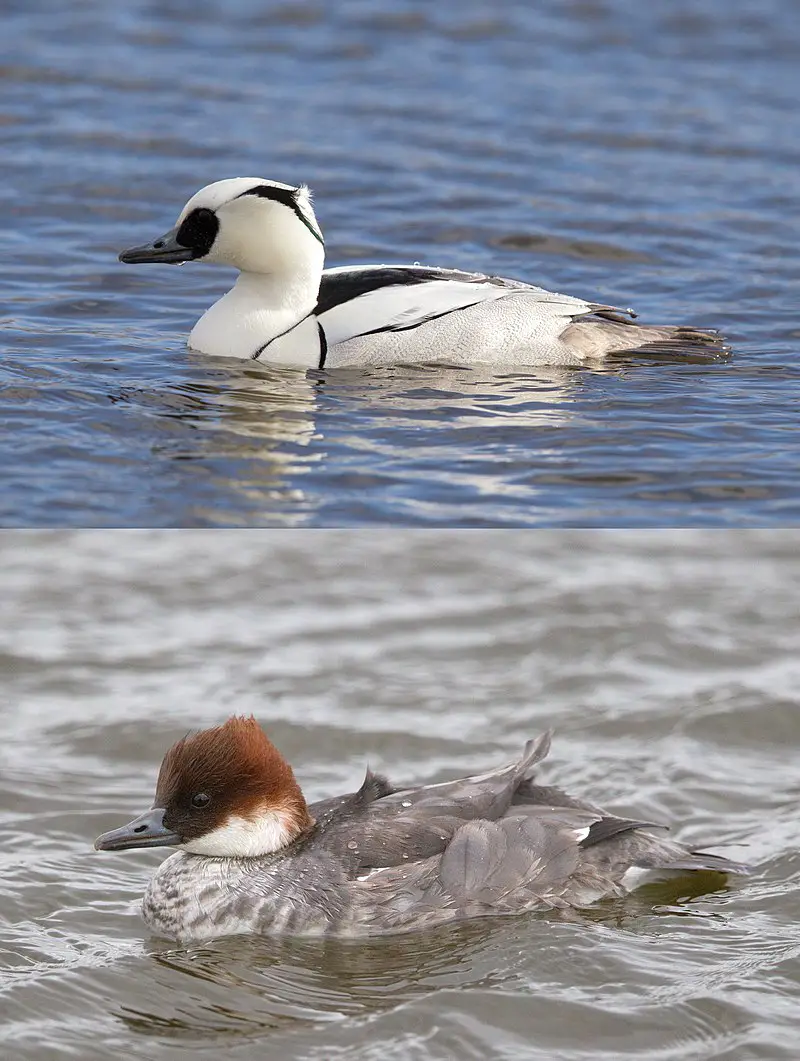
The Smew is a unique duck species, known as the only living member of the Mergellus genus. Its name comes from Latin, with “Mergellus” meaning a diminutive of Mergus and “albellus” referring to its white appearance.
While closely related to the Mergus species, the Smew may also have some similarities with the Goldeneyes. Interestingly, this bird has been known to hybridize with the common Goldeneye.
The Smew is a seaduck and a beautiful sight with its striking white and black plumage.
Scientific classification:
| Kingdom | Animalia |
| Phylum | Chordata |
| Class | Aves |
| Order | Anseriformes |
| Family | Anatidae |
| Genus | Mergellus |
| Species | M. albellus |
Also Featured In: Most Common Birds of Netherlands Island,
50. Common Firecrest
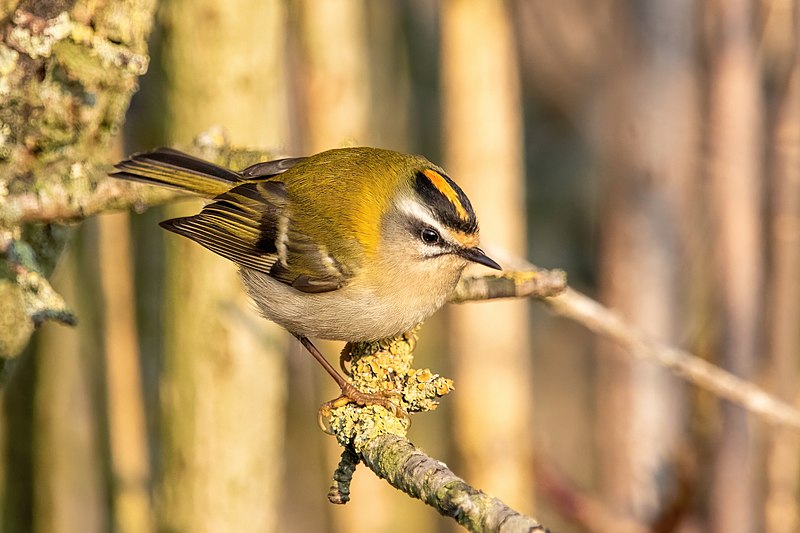
The Common Firecrest, a tiny bird from the kinglet family, is found in temperate Europe and northwest Africa. It is known for its bright orange and black striped crest, distinguishing it from other kinglets.
This bird is partially migratory, with those in central Europe moving southwards during winters.
The Firecrest breeds in different parts of its range and has a unique subspecies in the Balearic Islands and North Africa.
Despite being small, this bird has a melodious song and can be heard singing during the breeding season.
The Common Firecrest is a fascinating bird that adds colour and charm to the forests and woodlands it inhabits.
Scientific classification:
| Kingdom | Animalia |
| Phylum | Chordata |
| Class | Aves |
| Order | Passeriformes |
| Family | Regulidae |
| Genus | Regulus |
| Species | R. ignicapilla |
Also Featured In: Birds of Norfolk, Birds that can be Seen in October
51. Cirl Bunting
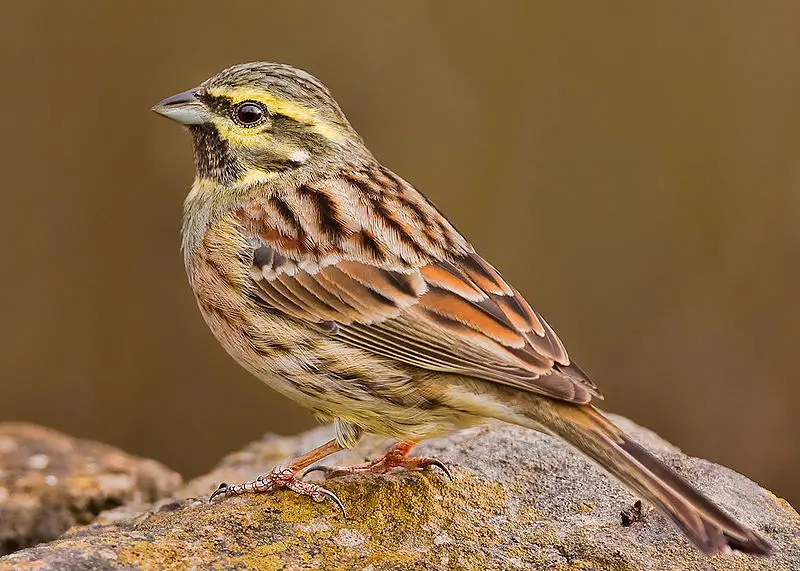
The Cirl Bunting is a passerine bird that belongs to the Emberizidae family. It is commonly found in southern Europe, including the Mediterranean islands and North Africa.
Unlike other species, it is a resident bird and does not travel during winter. The bird prefers to reside in open areas with some scrub and is prevalent in such regions.
Modern authors separated the finches and Emberizidae families into two distinct groups.
The Cirl Bunting is a warm-weather bird that breeds in southern Europe, often in areas with light vegetation. Its scientific name is Emberiza circus.
Scientific classification:
| Kingdom | Animalia |
| Phylum | Chordata |
| Class | Aves |
| Order | Passeriformes |
| Family | Emberizidae |
| Genus | Emberiza |
| Species | E. cirlus |
Also Featured In: Most Common Birds of Sardinia, Most Popular Birds in Mallorca
Conclusion
In the world of avian diversity, these 51 flight birds offer a glimpse into the magnificent tapestry of winged creatures that grace our skies.
From the iconic Bald Eagle symbolizing freedom to the lightning-fast Peregrine Falcon, each bird tells a unique story of adaptation, survival, and beauty.
Some soar majestically, while others stealthily hunt their prey, and a few dazzle with their vibrant plumage.
Whether it’s the silent grace of the Barn Owl or the power of the Harpy Eagle, these birds remind us of the wonders of nature.
They inspire us to appreciate and protect the fragile ecosystems they inhabit, ensuring that these remarkable avian wonders continue to enrich our world for generations to come.